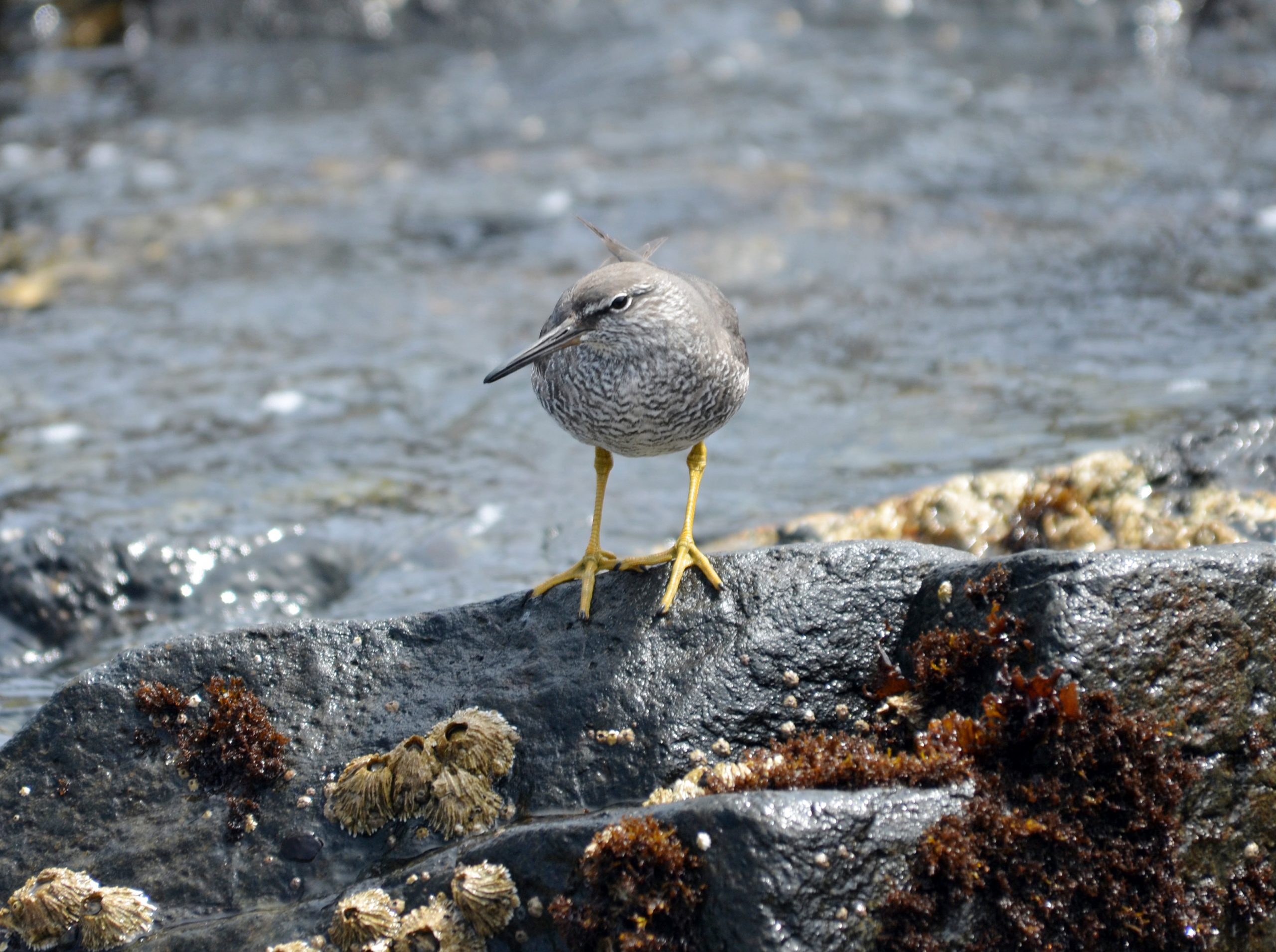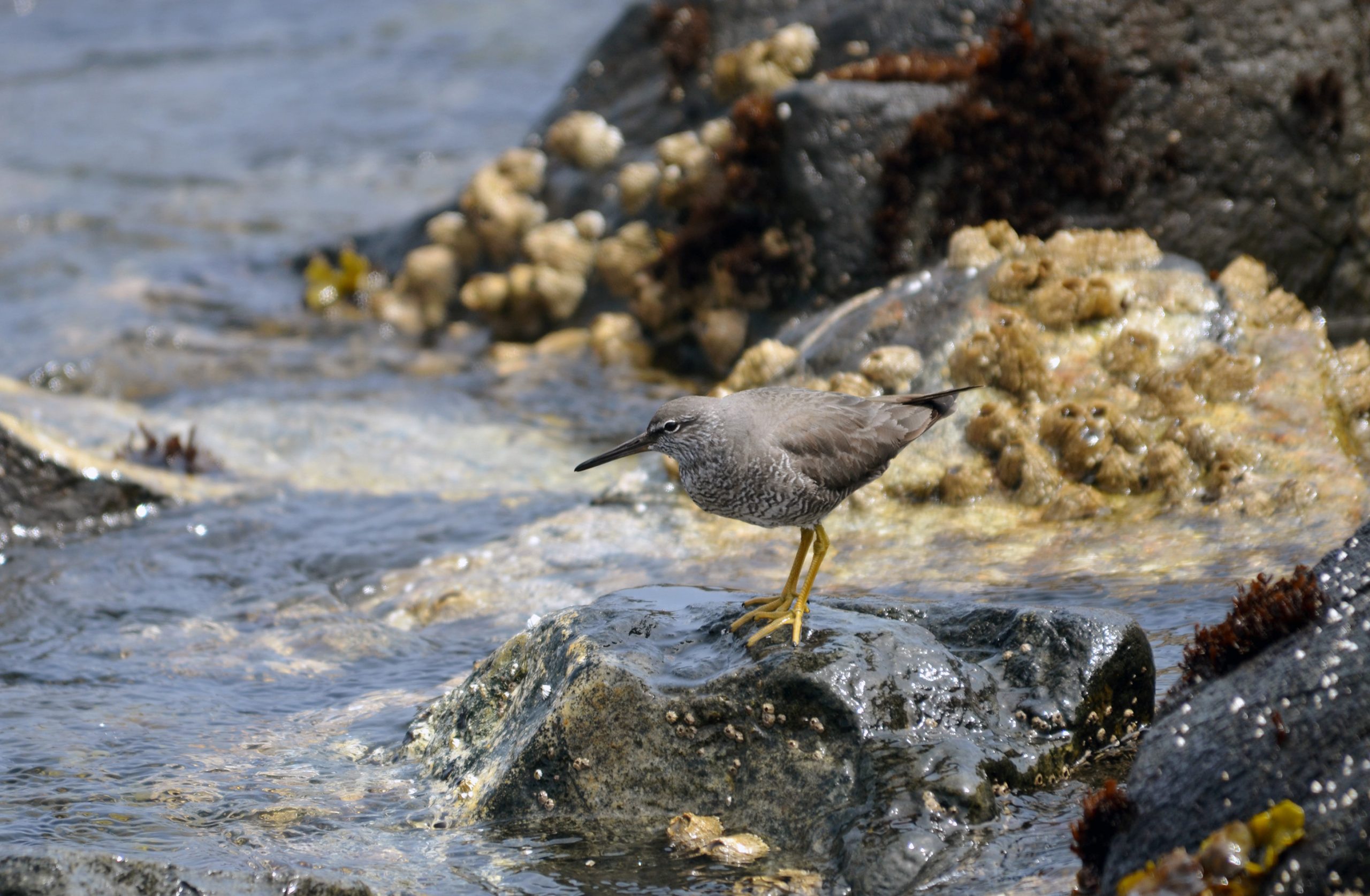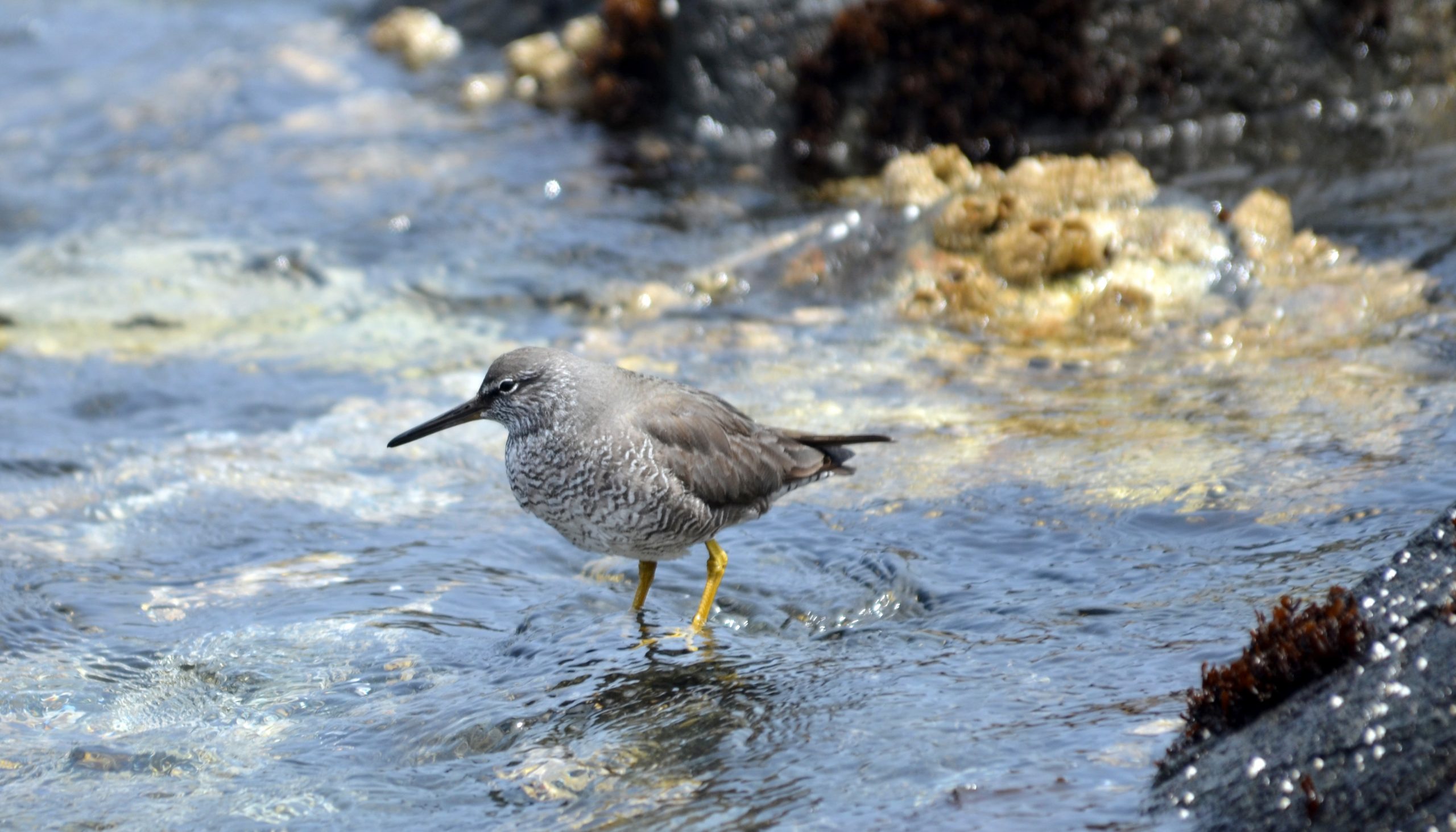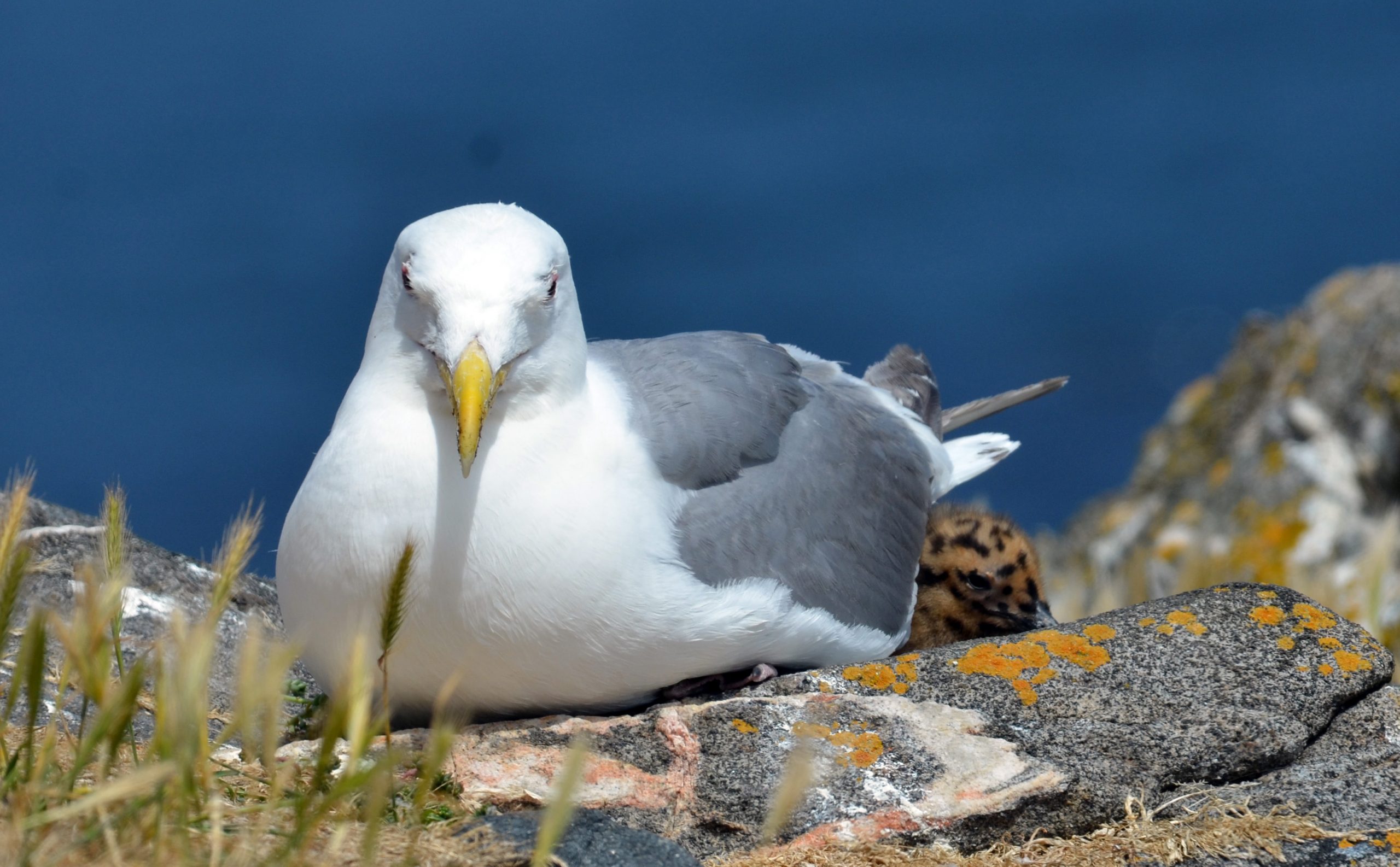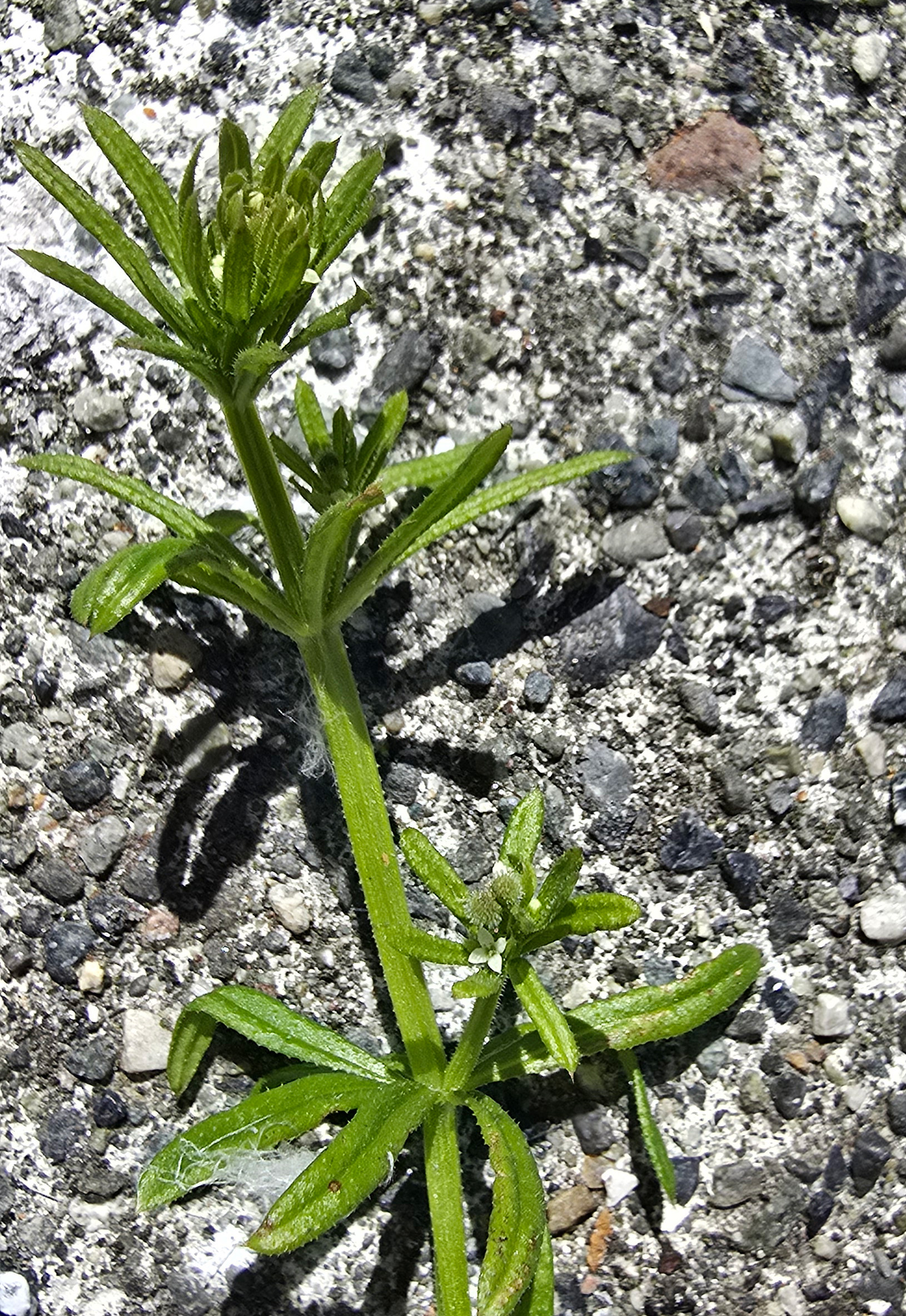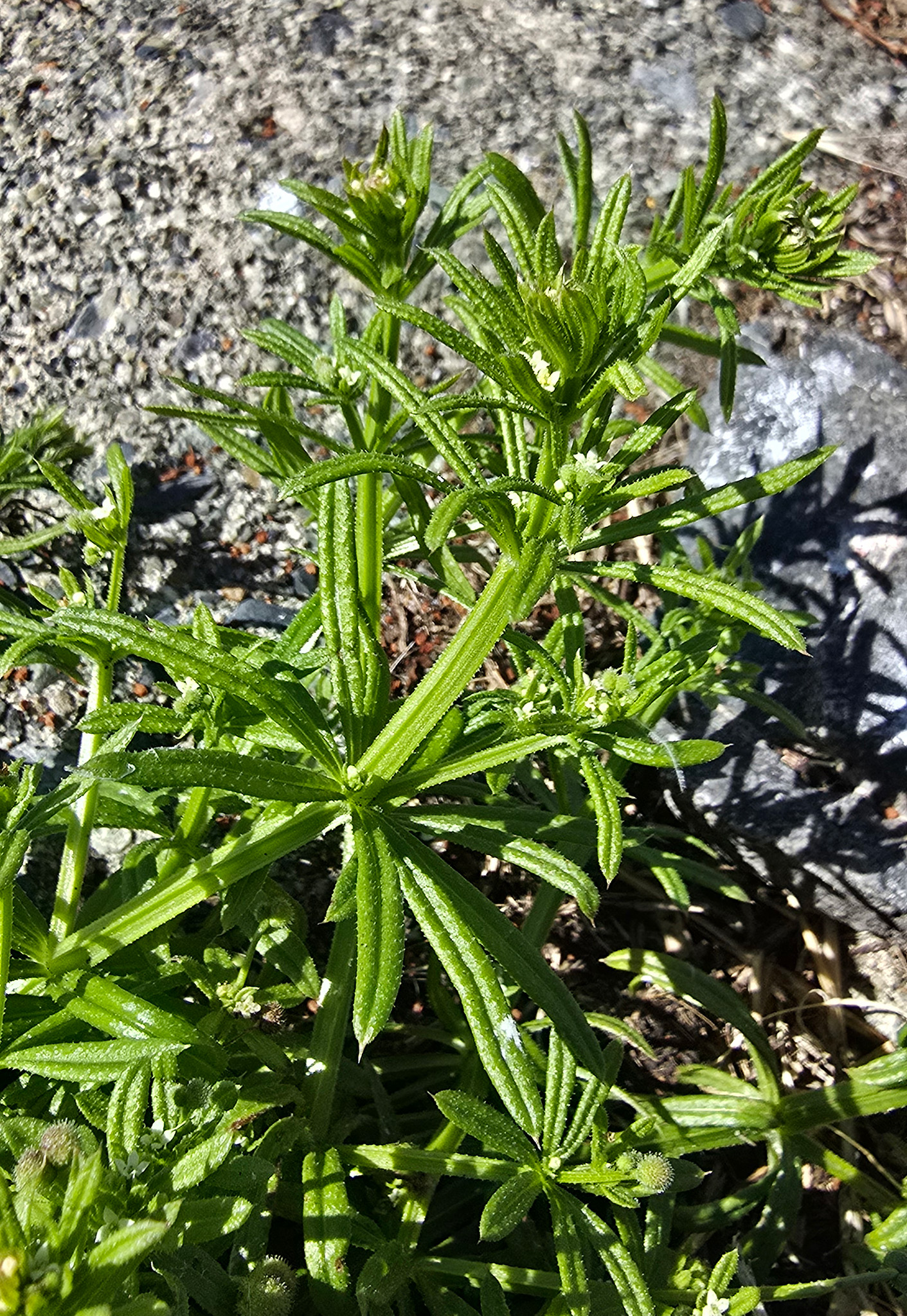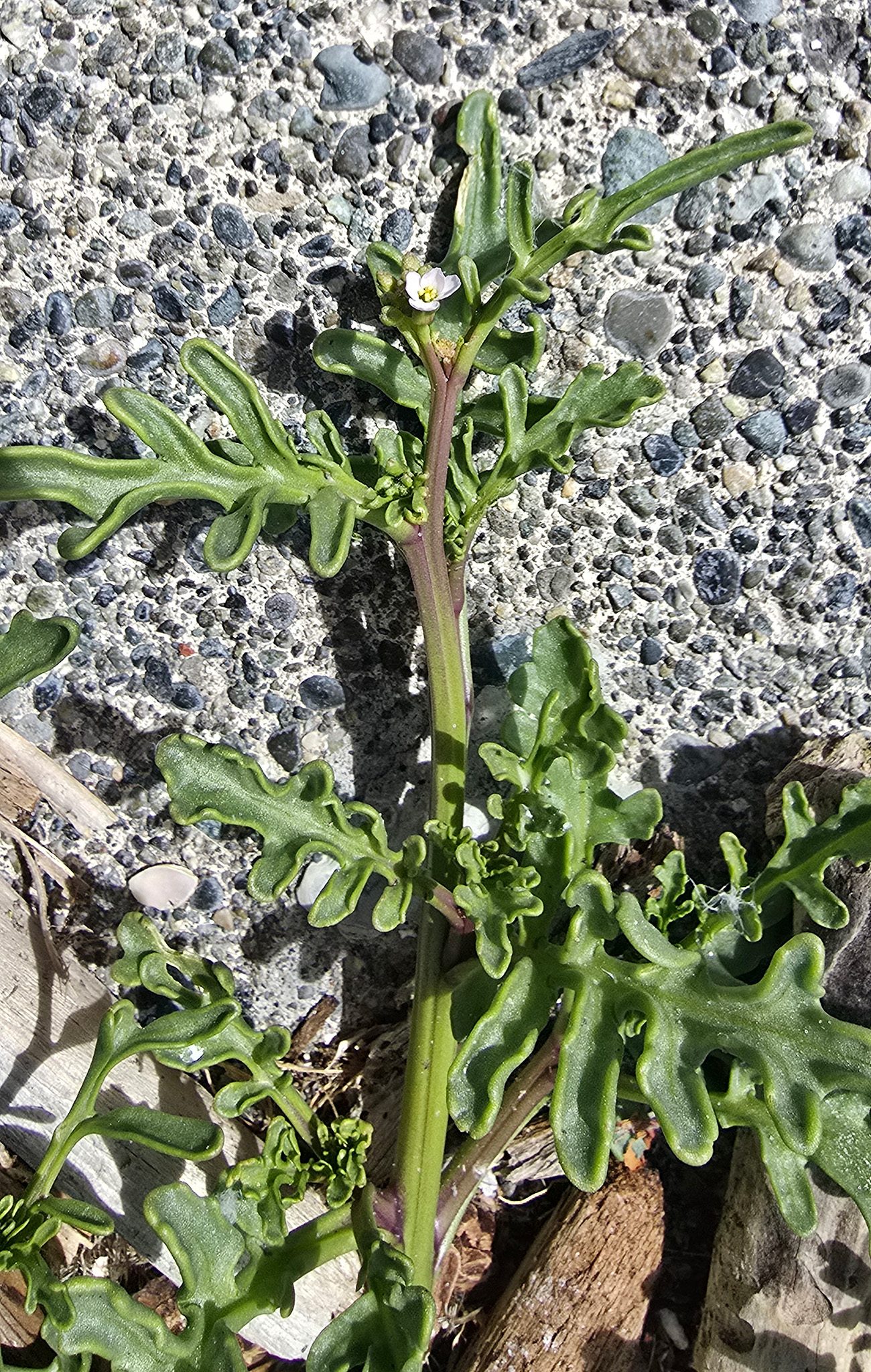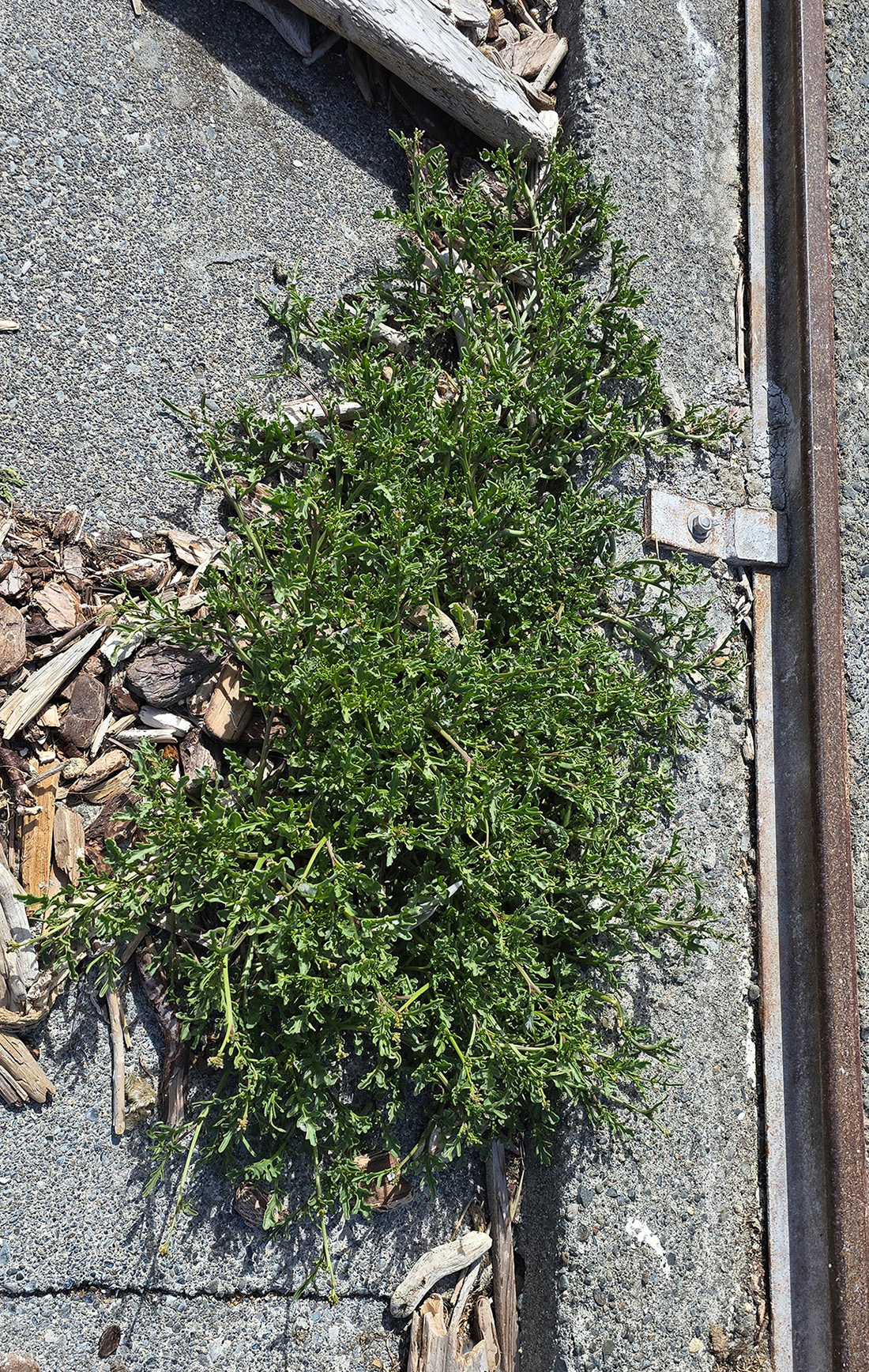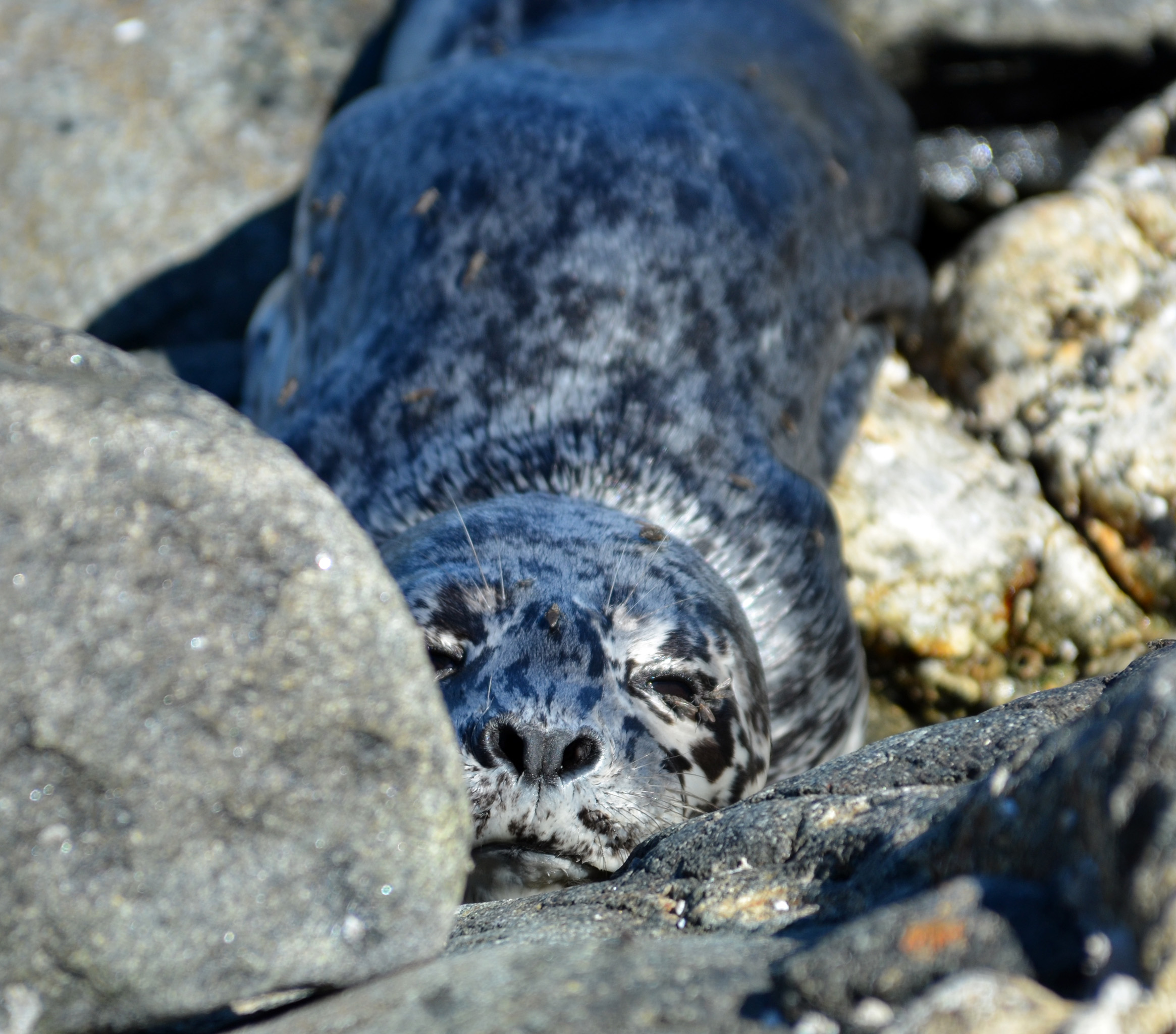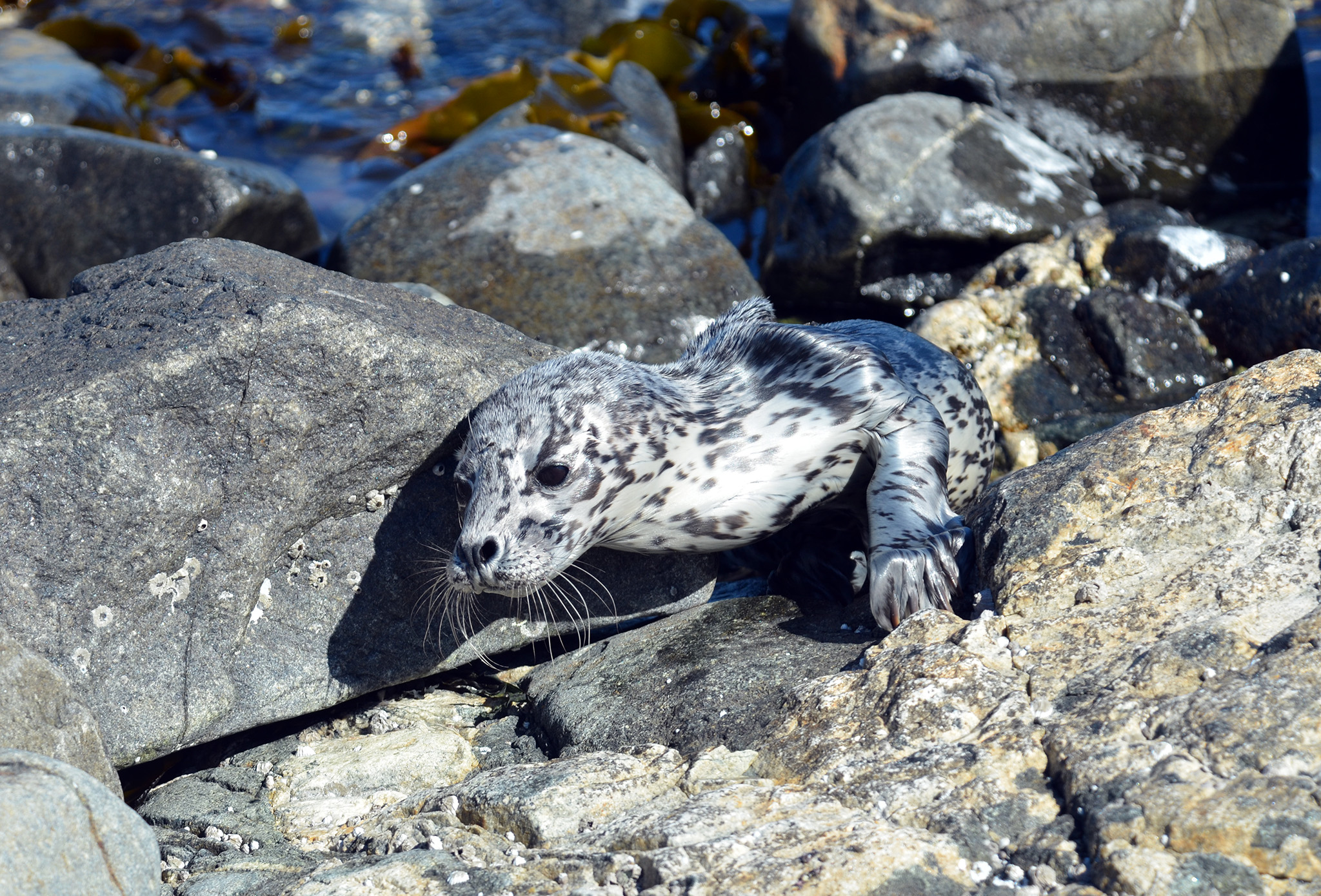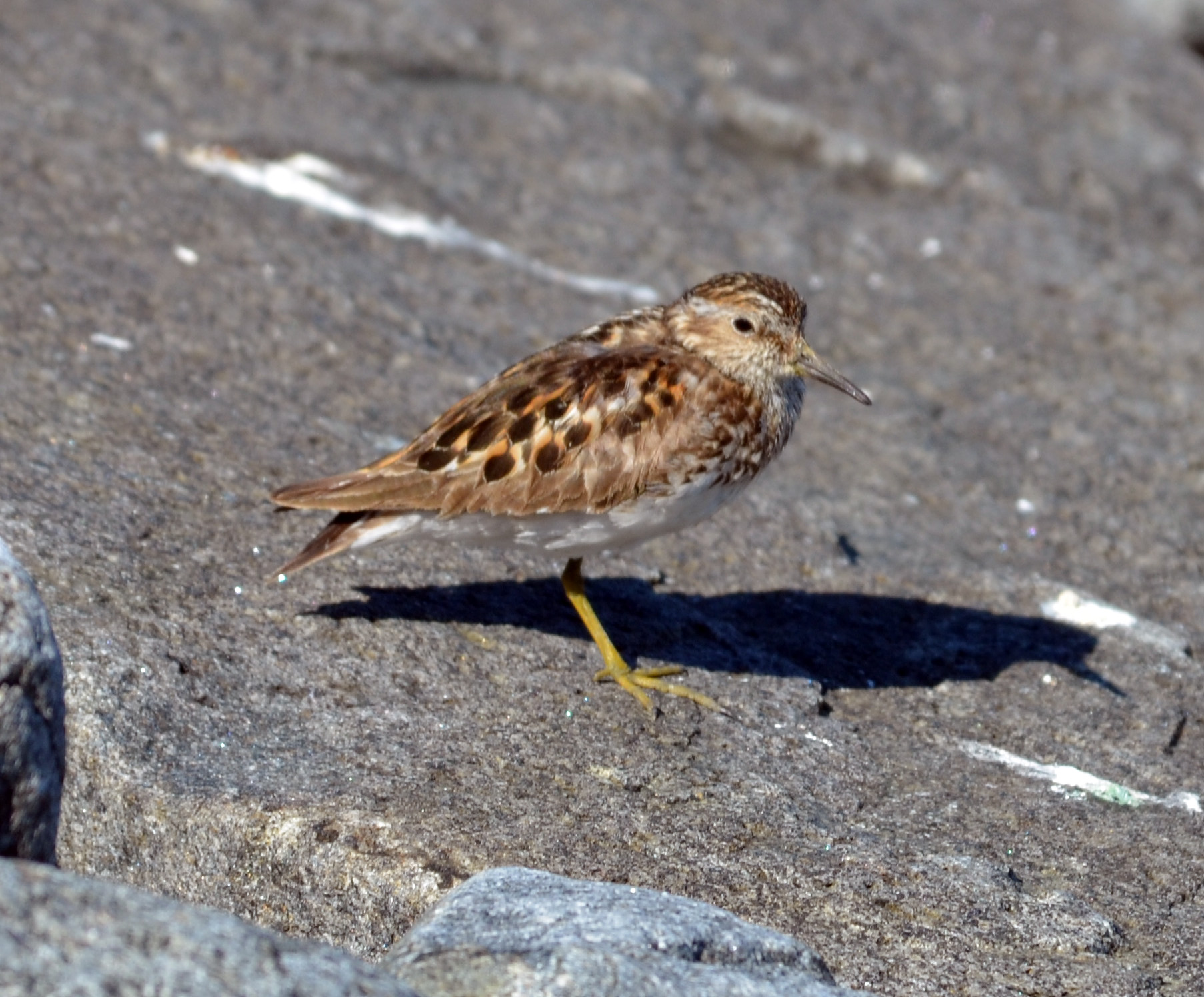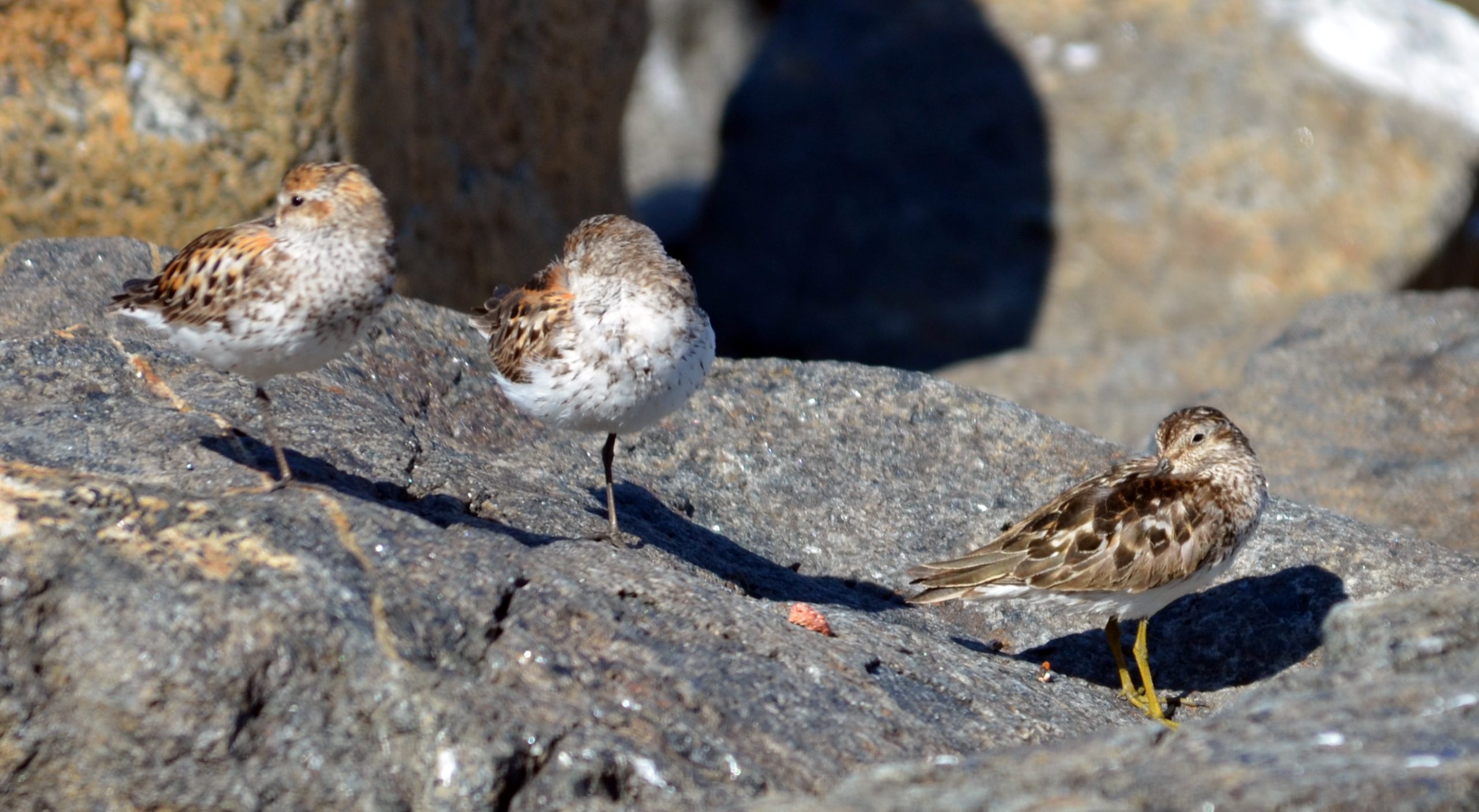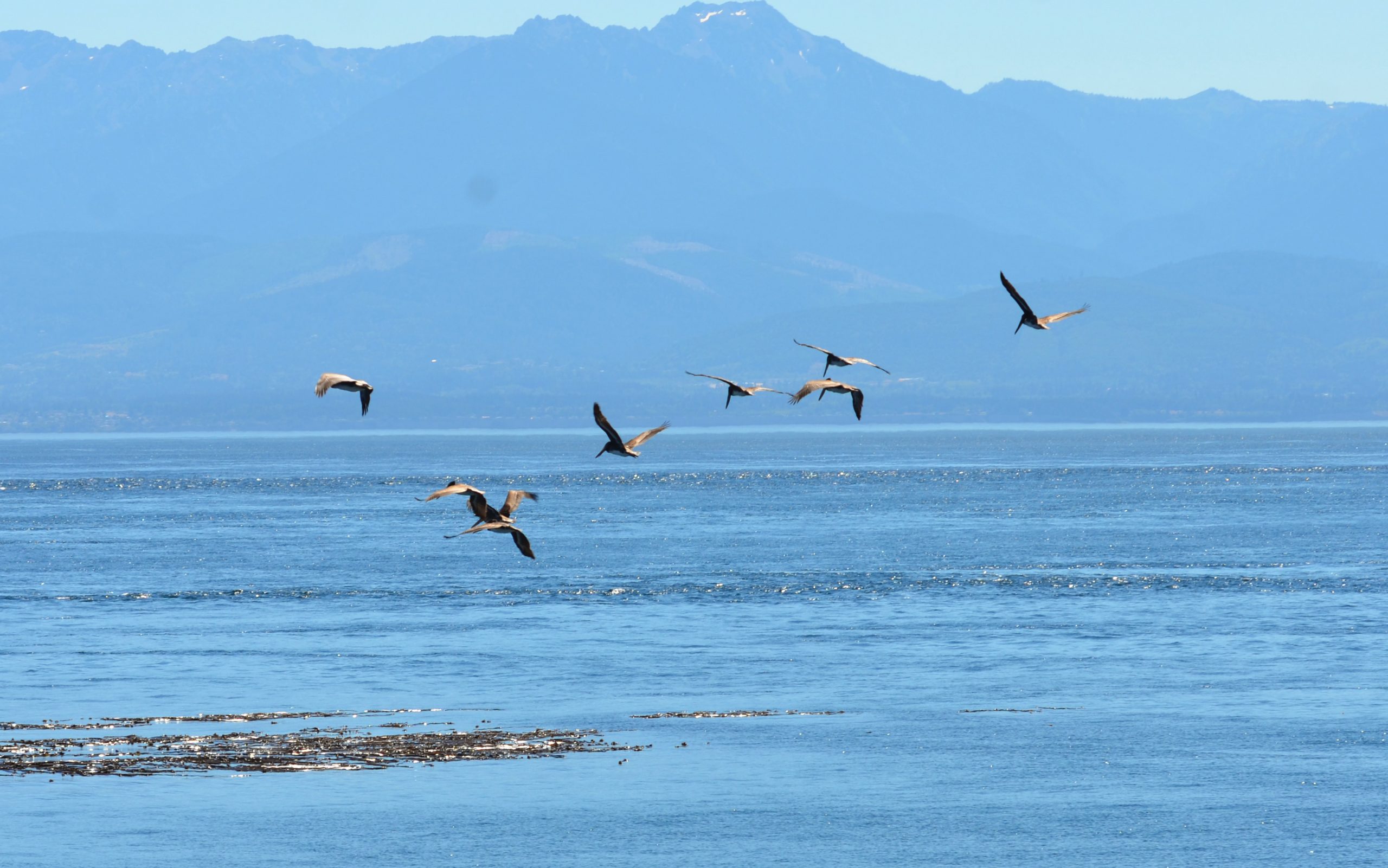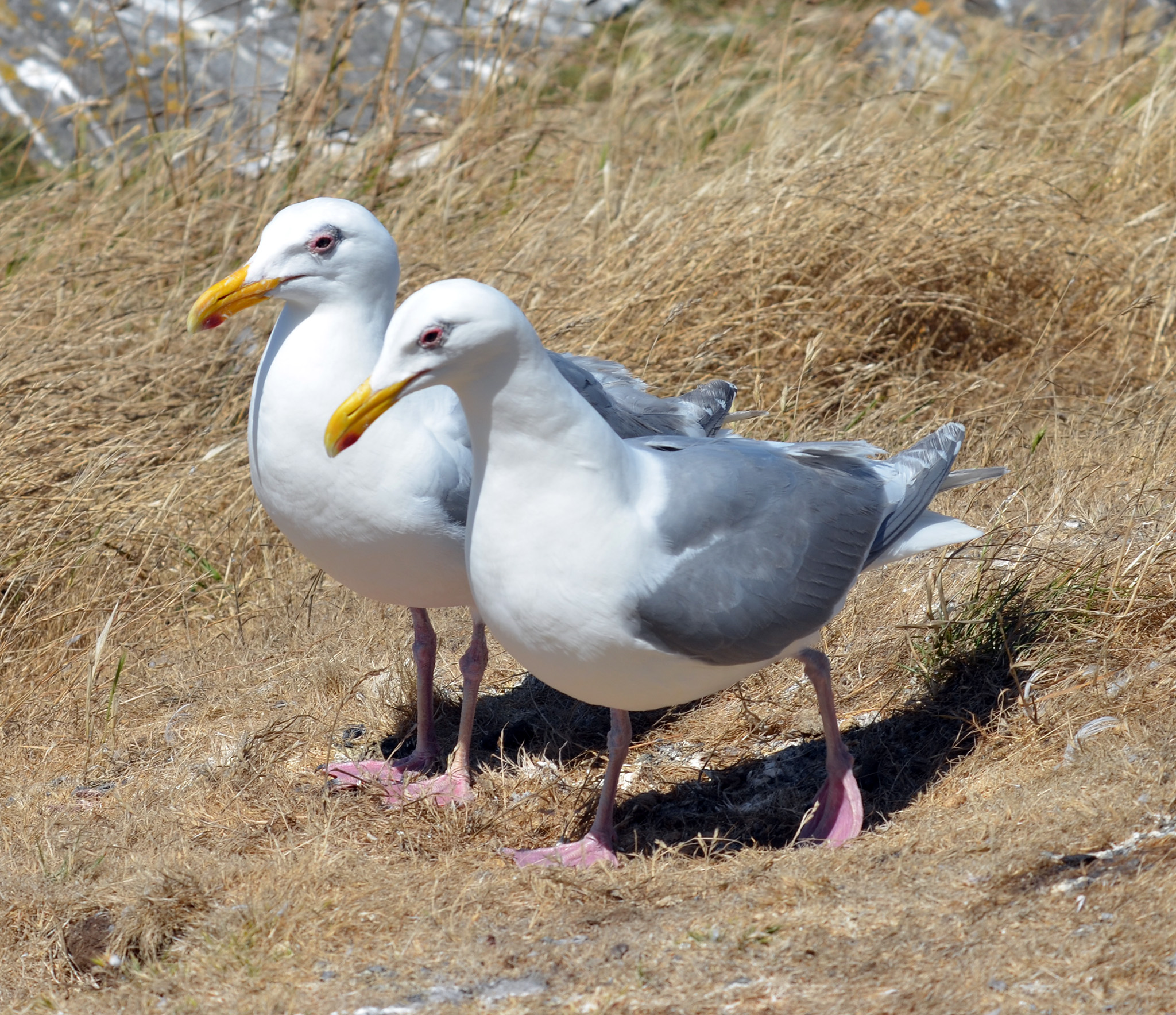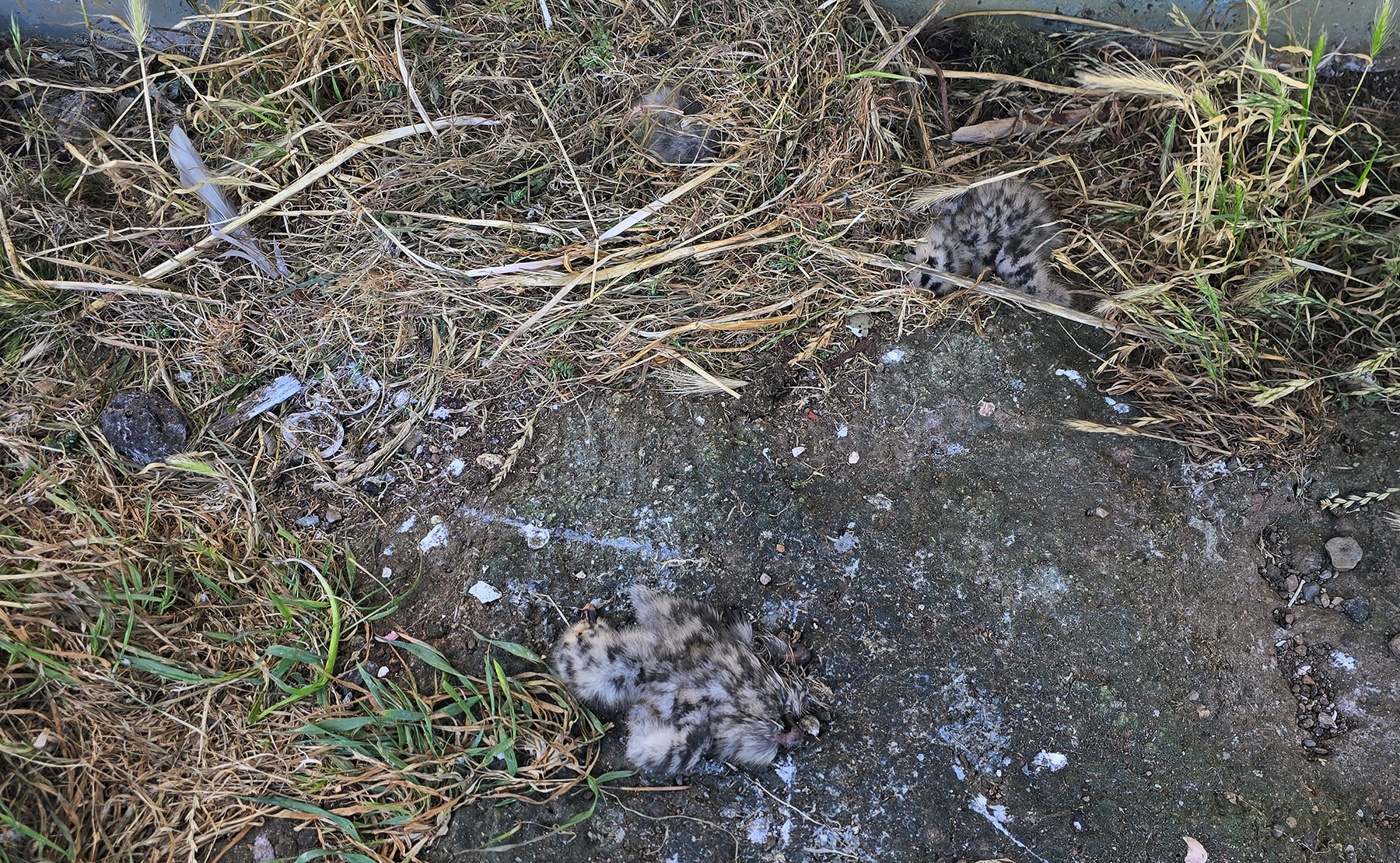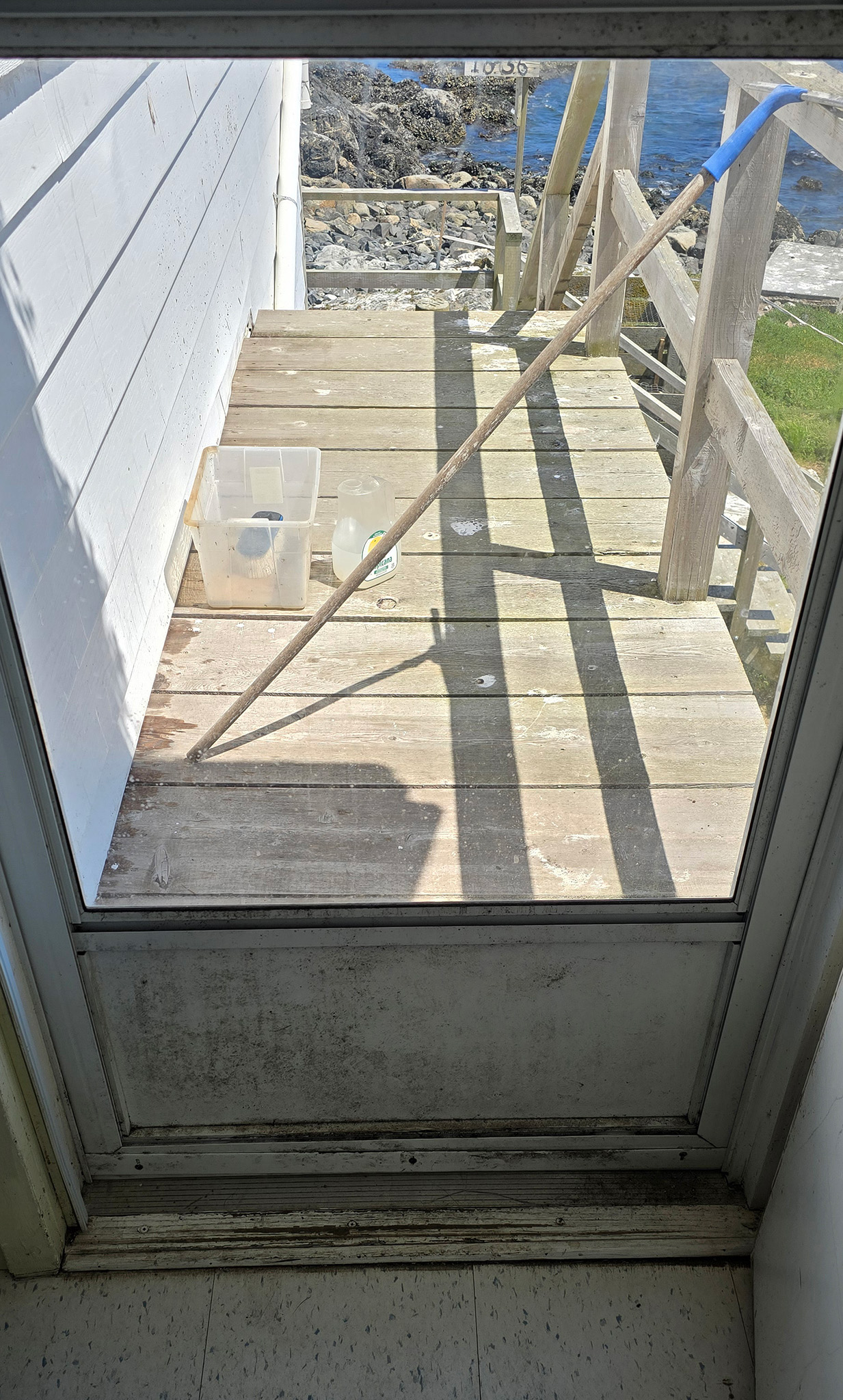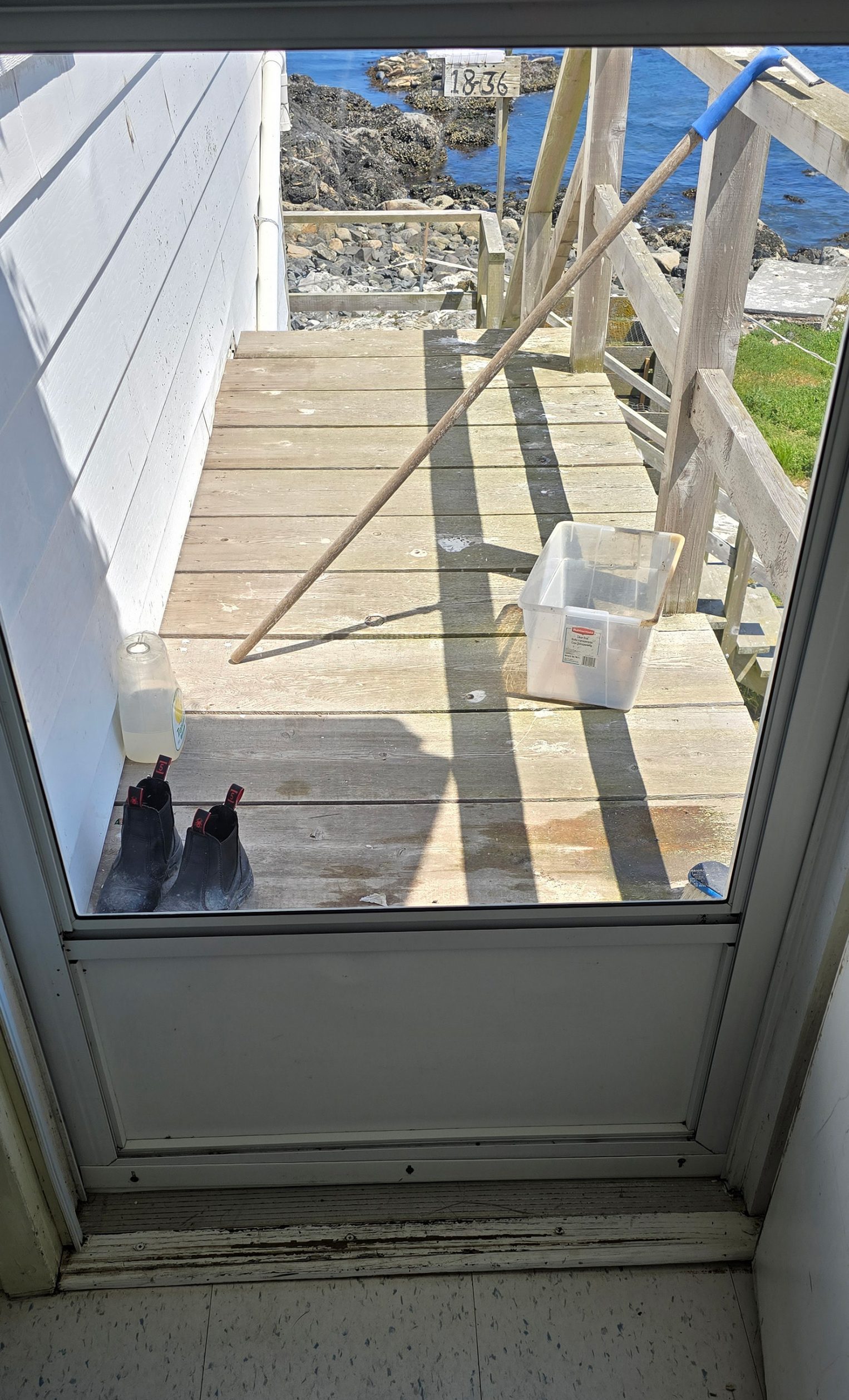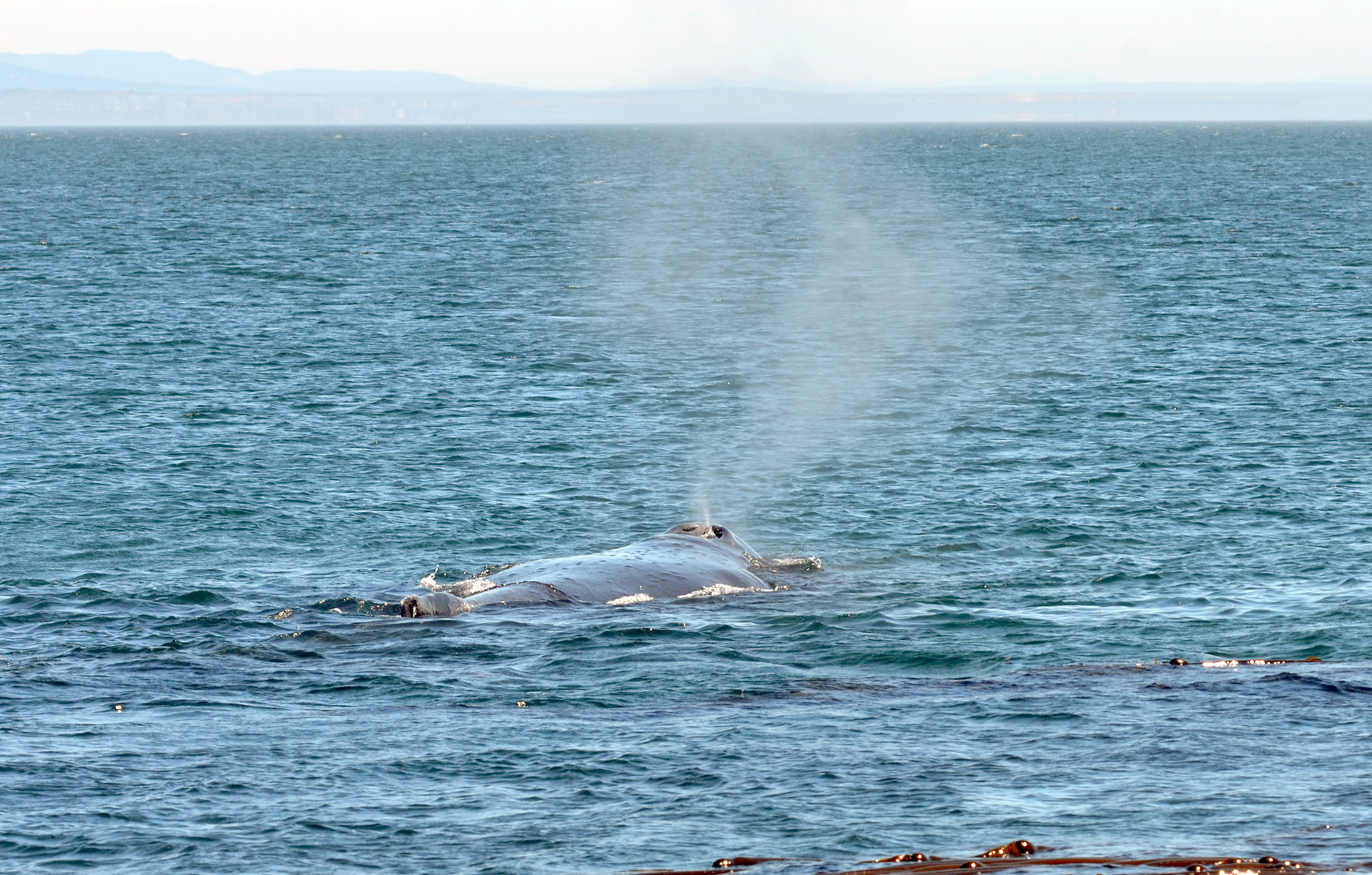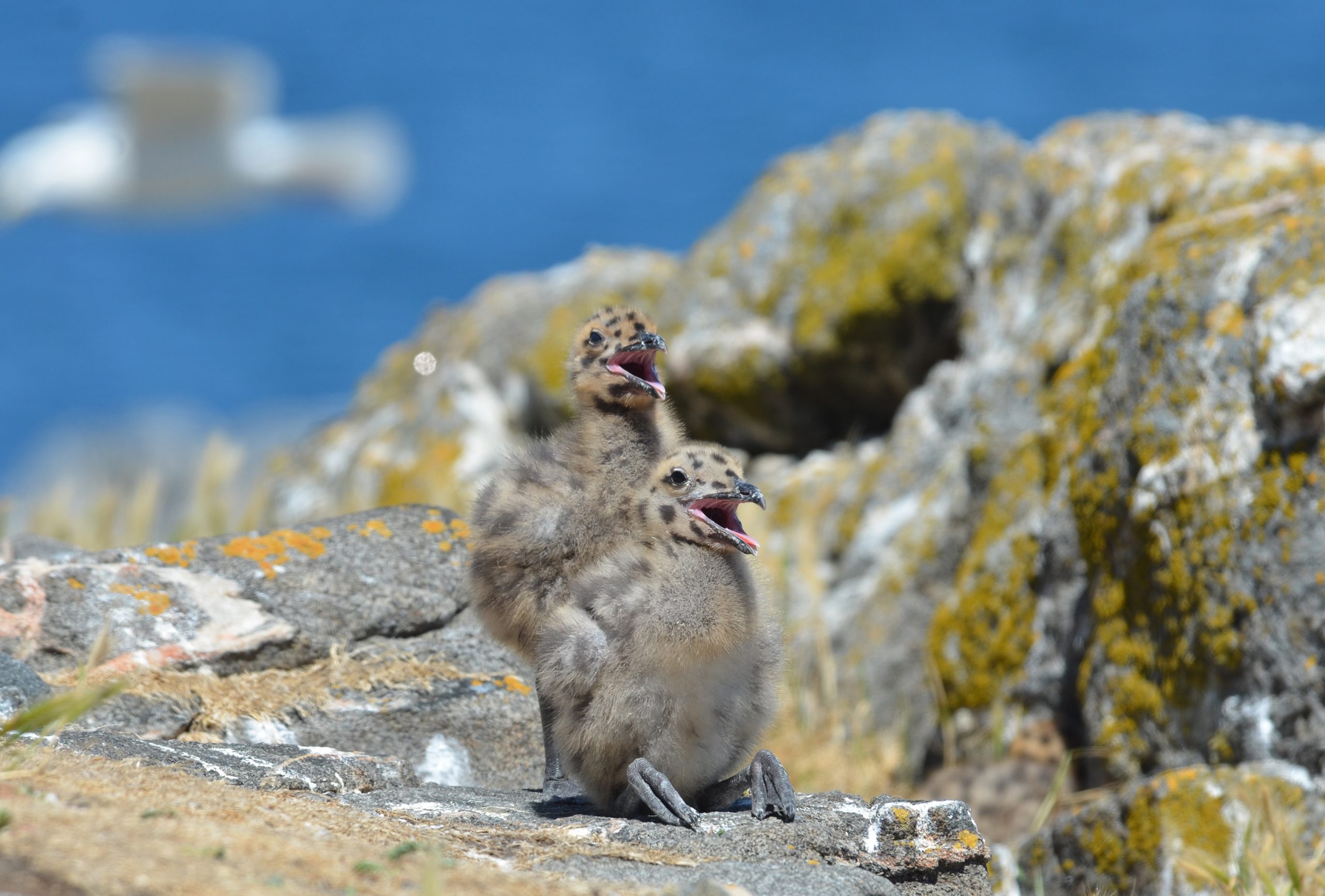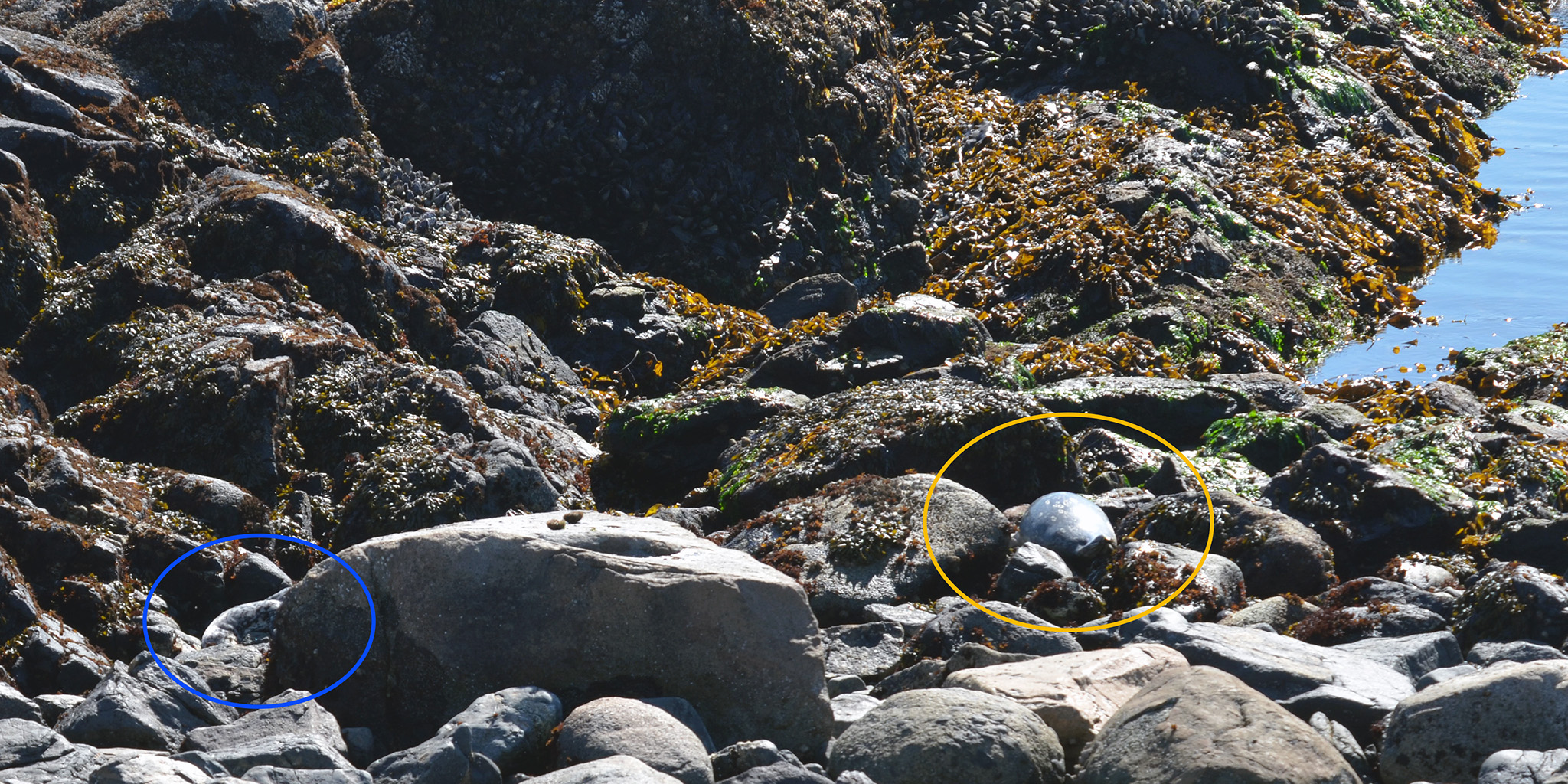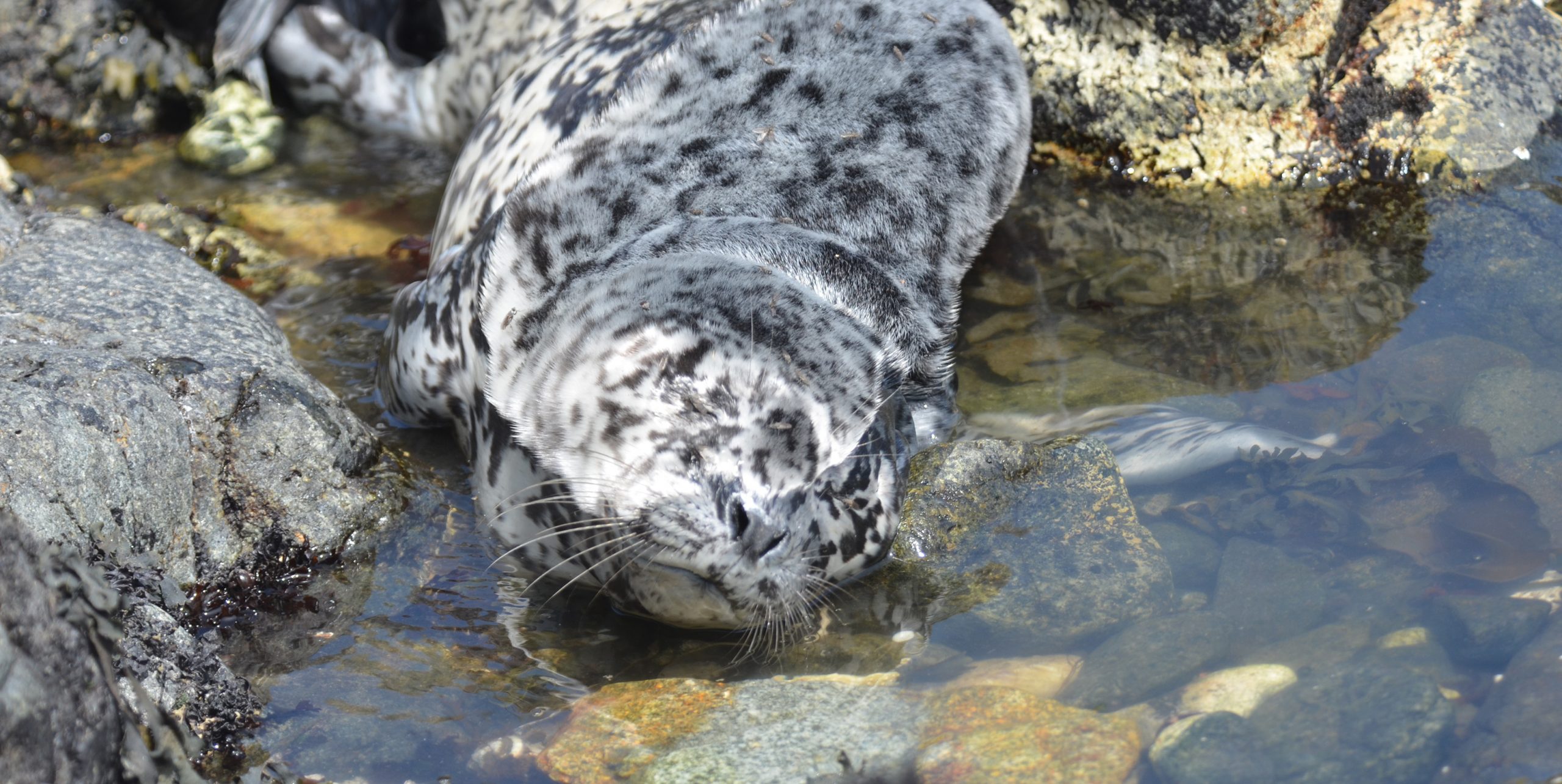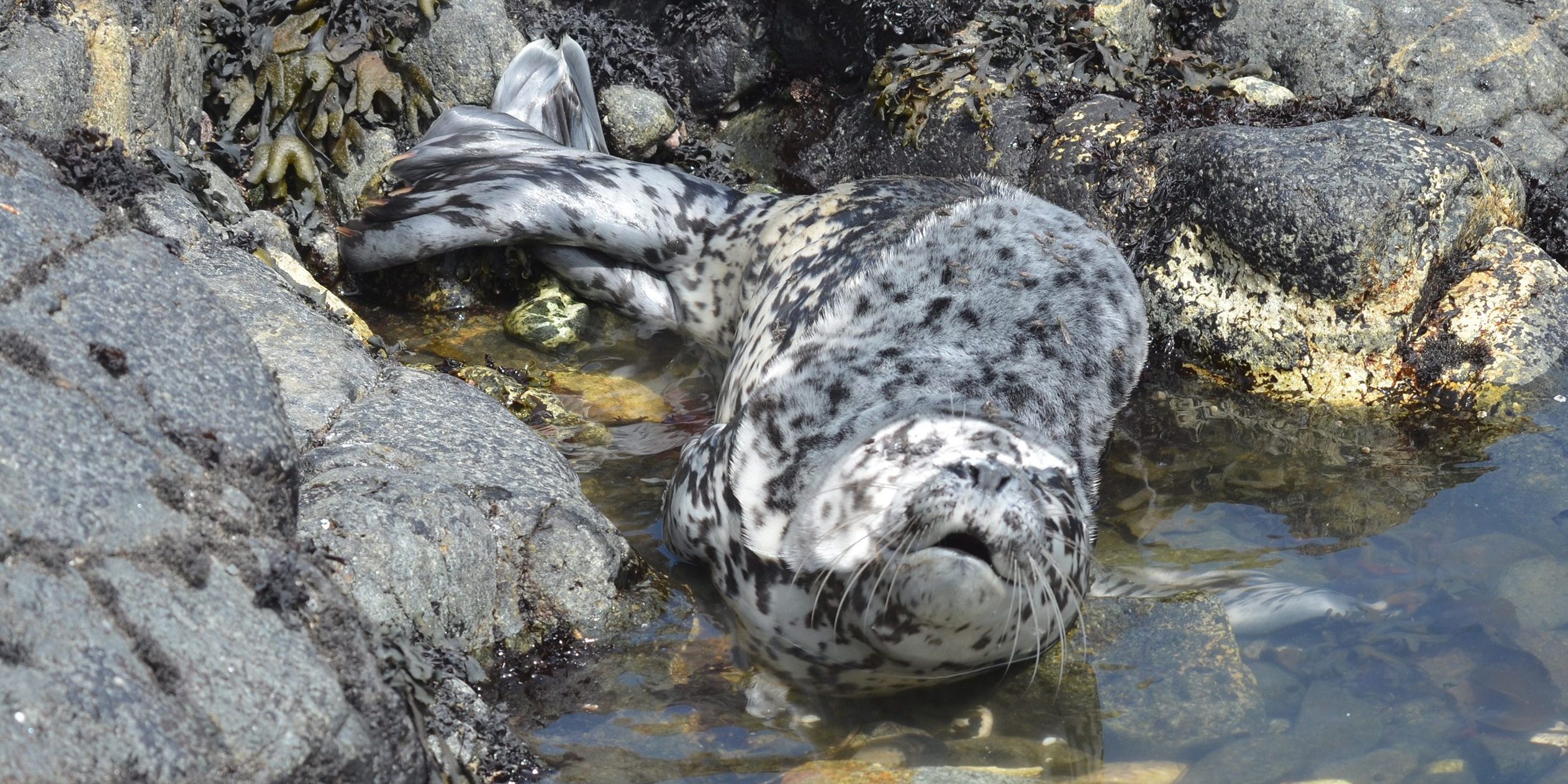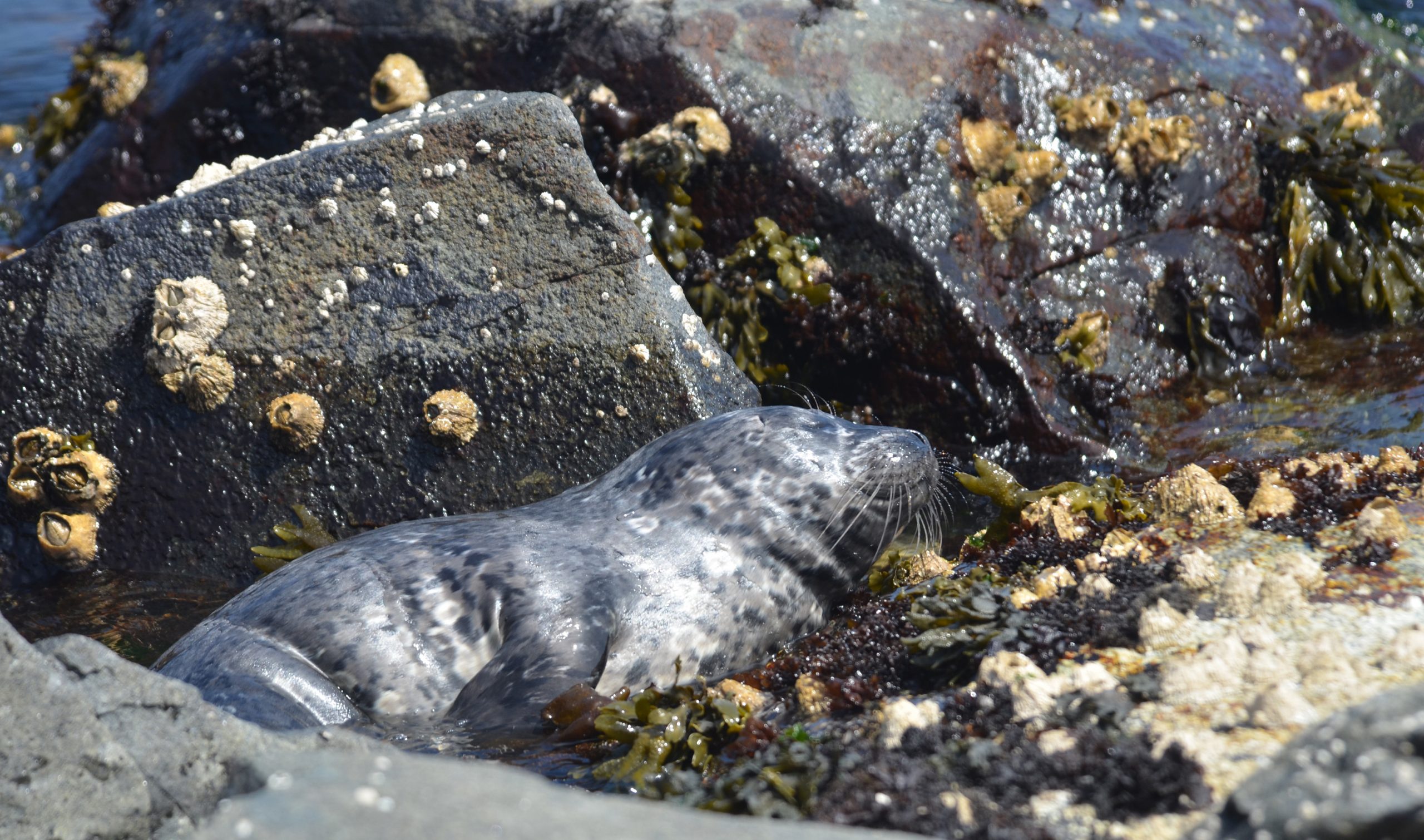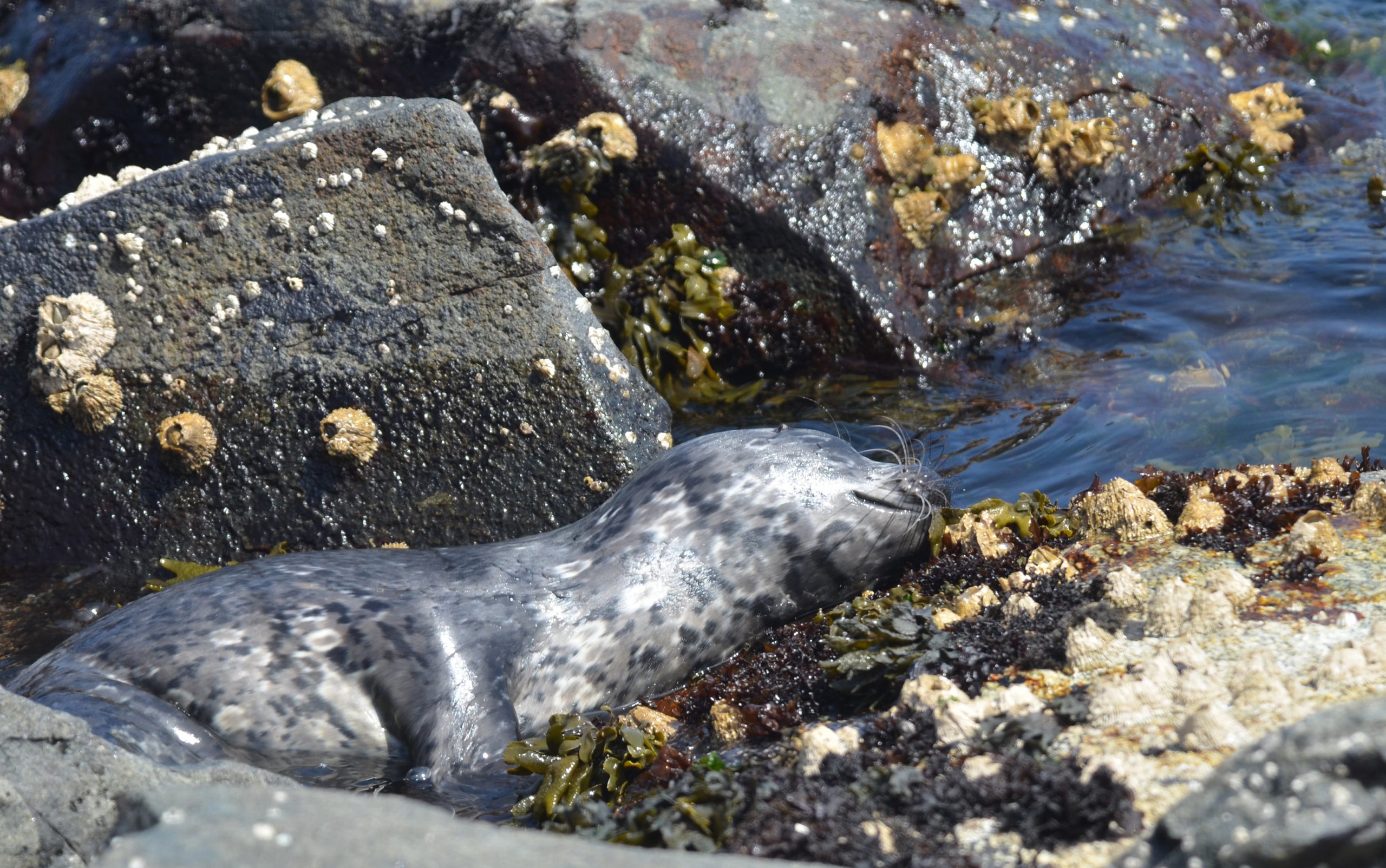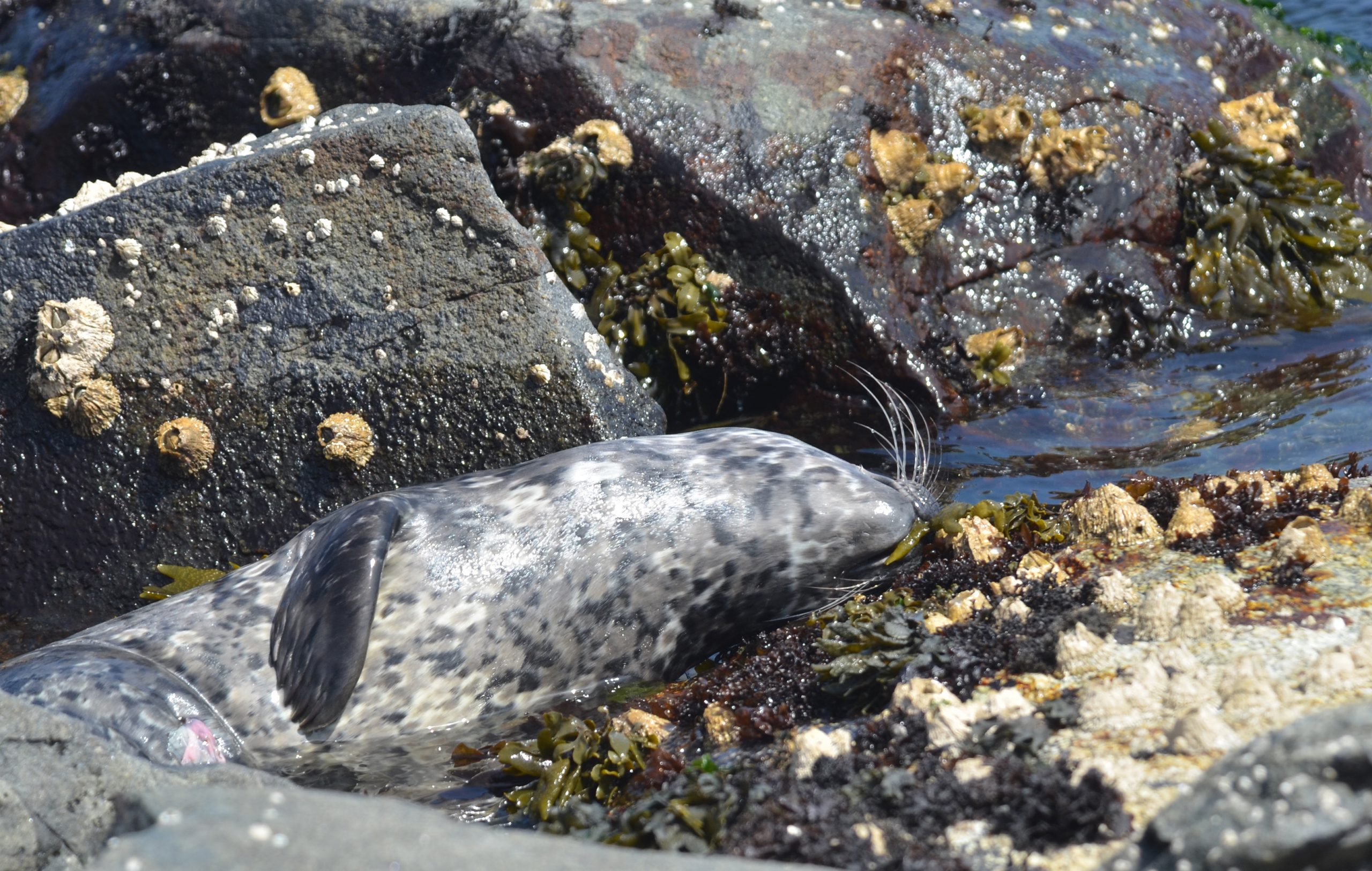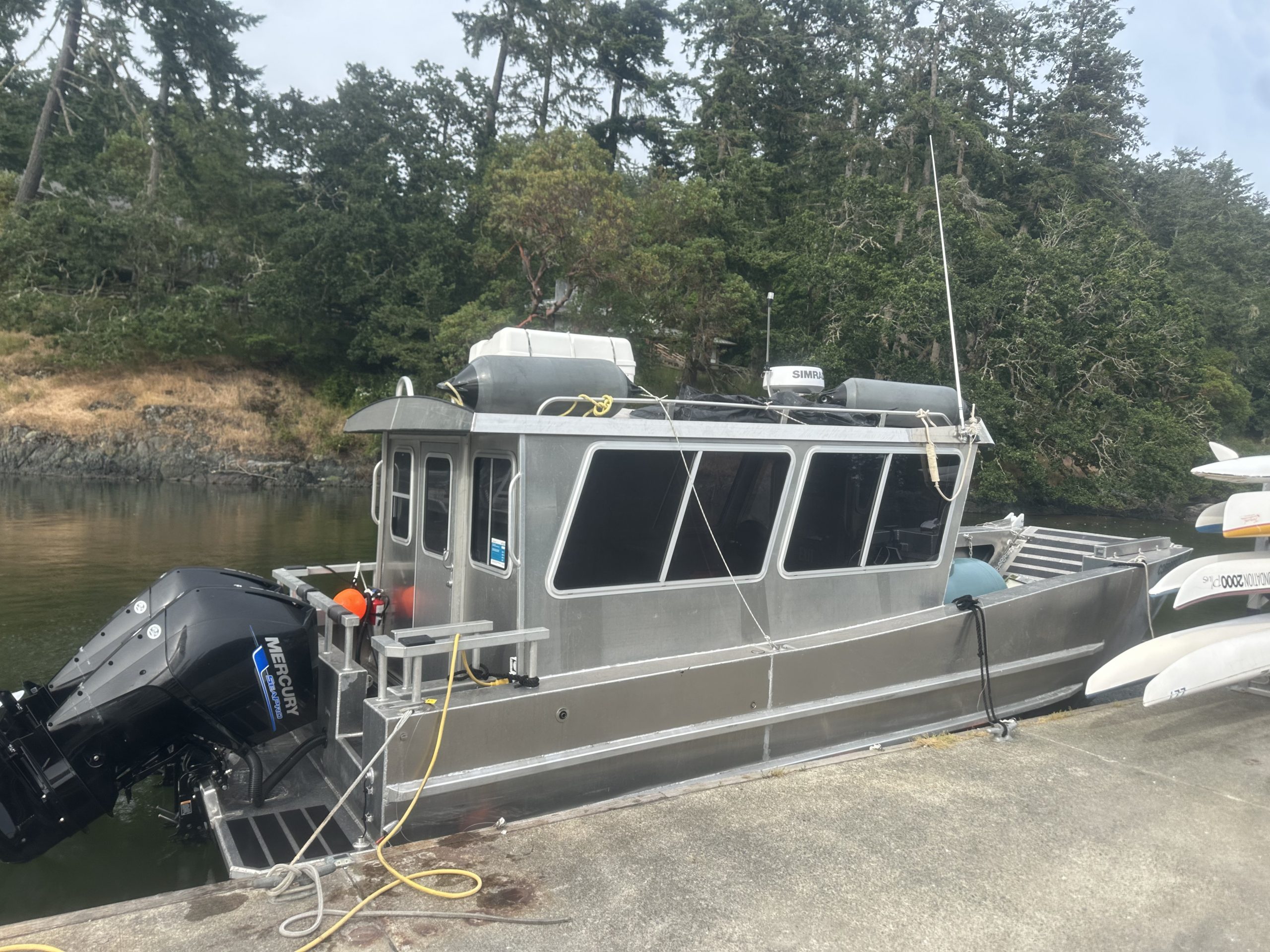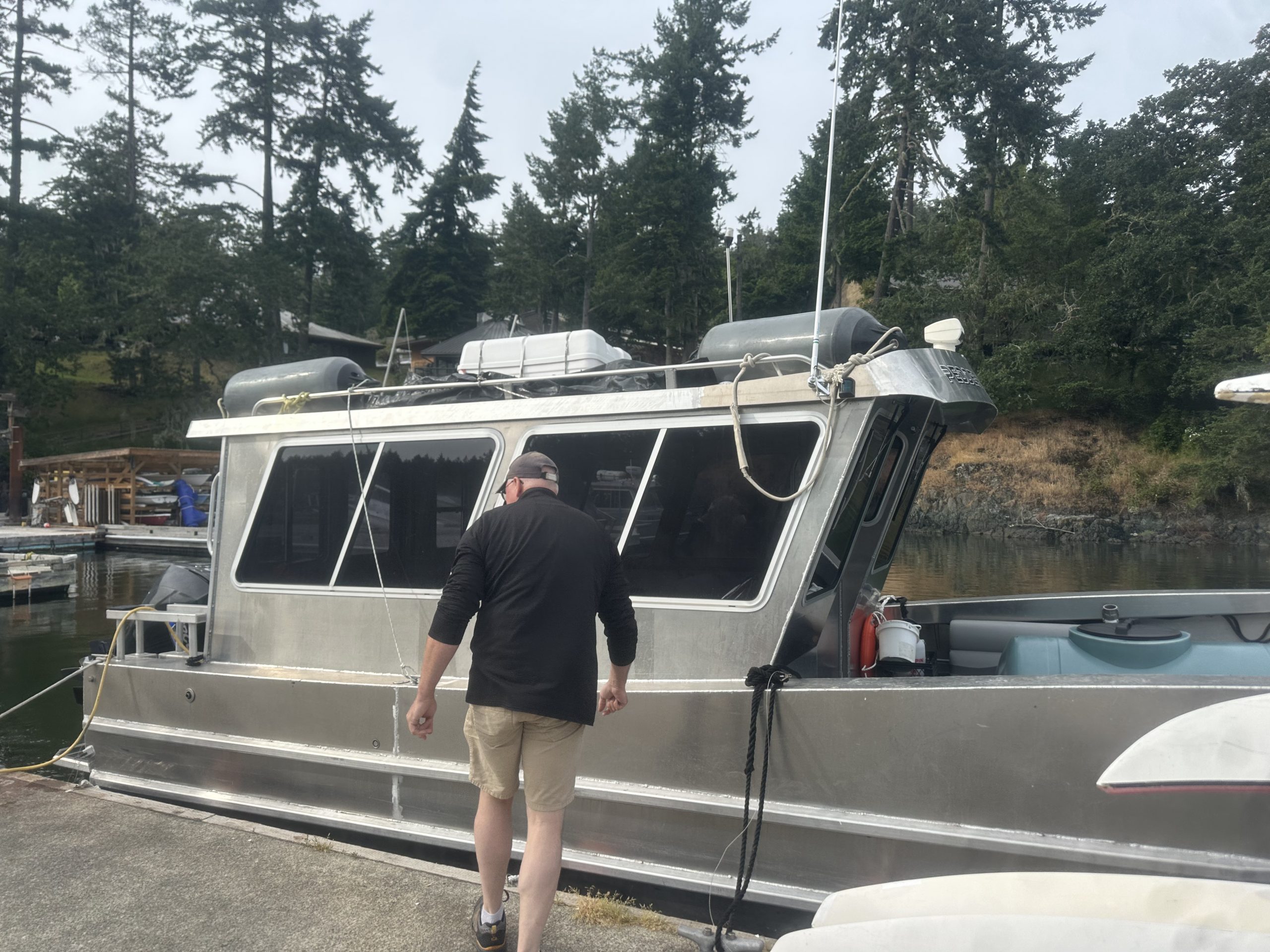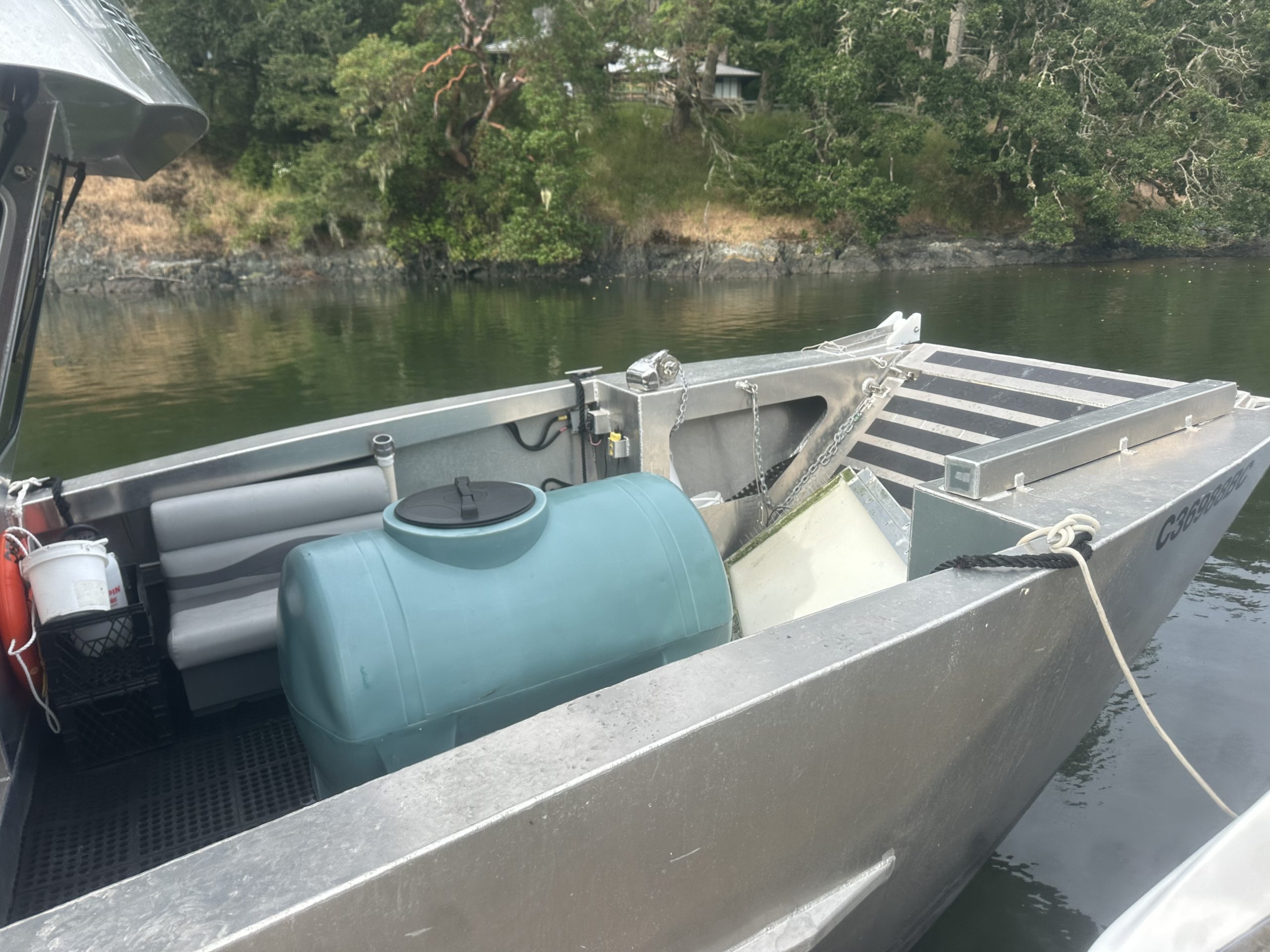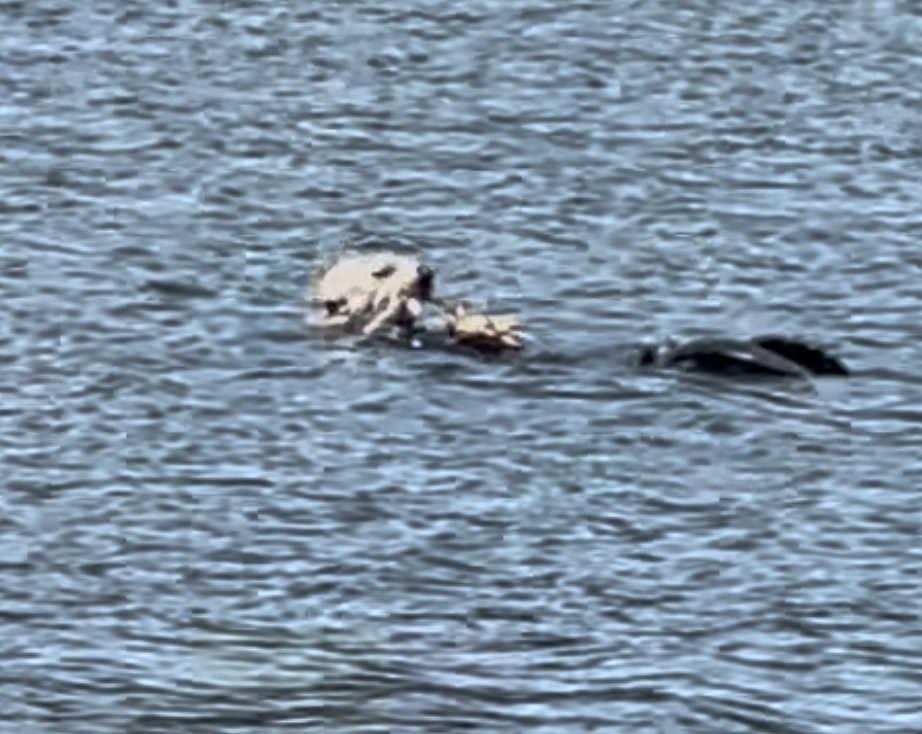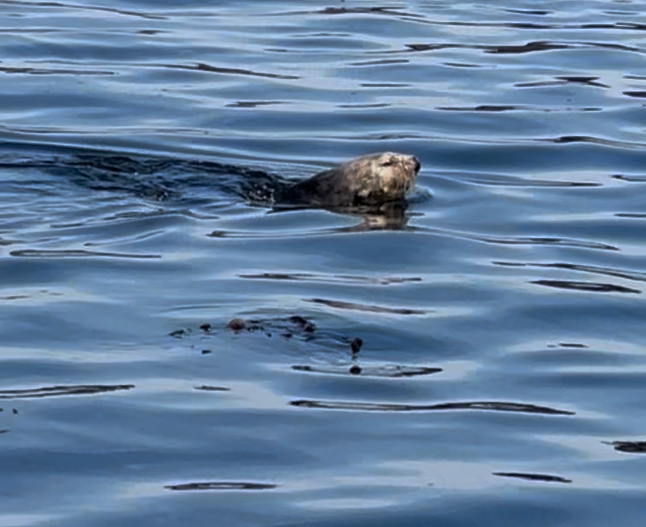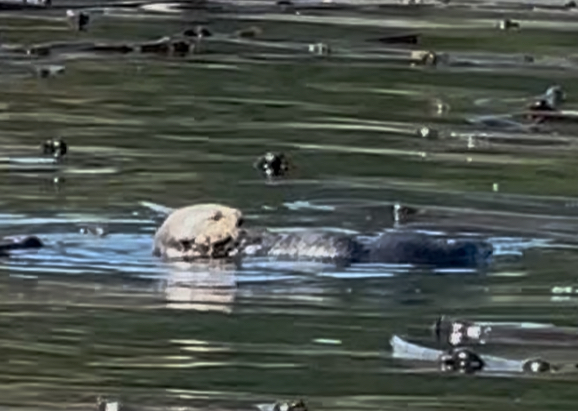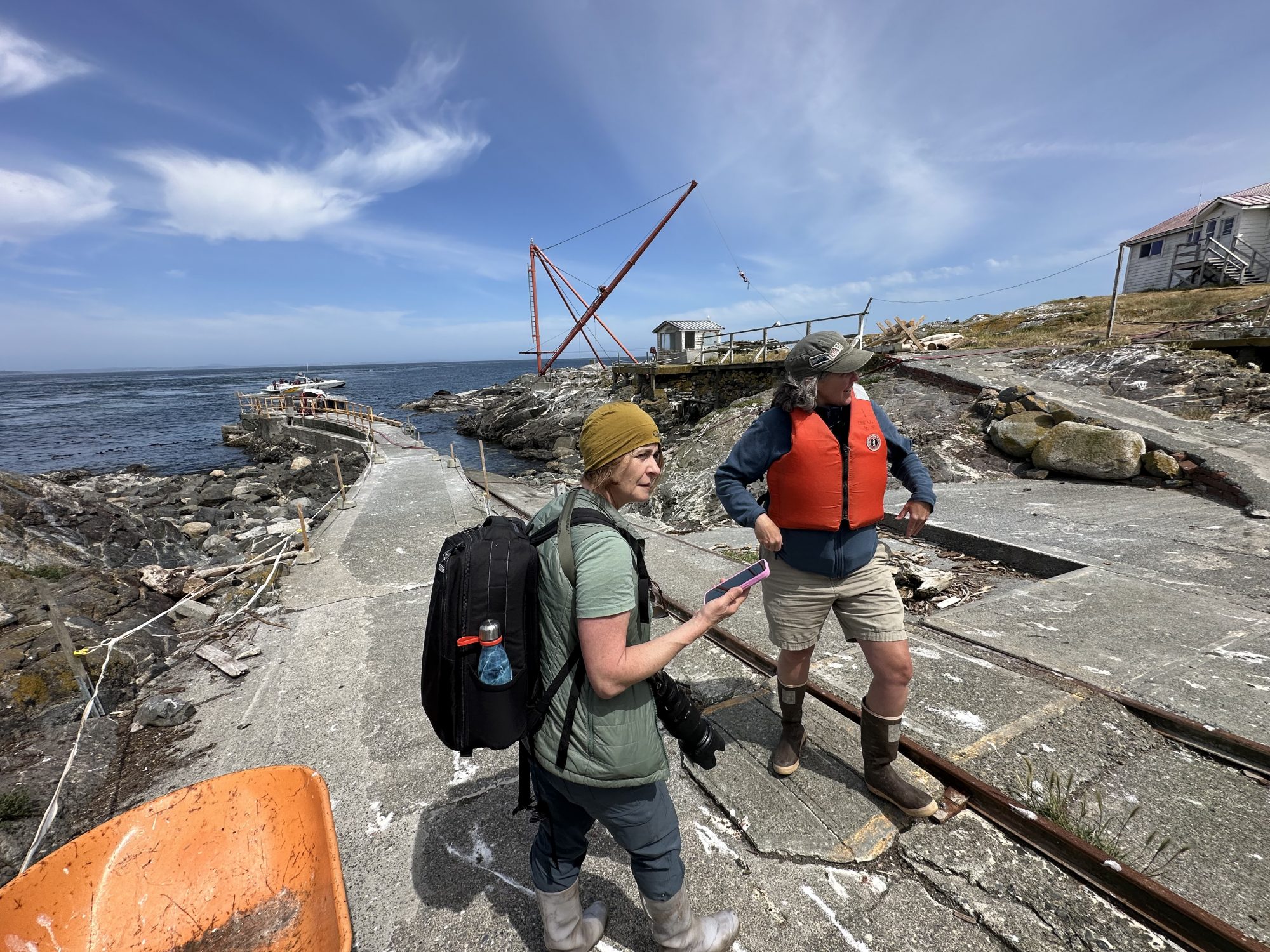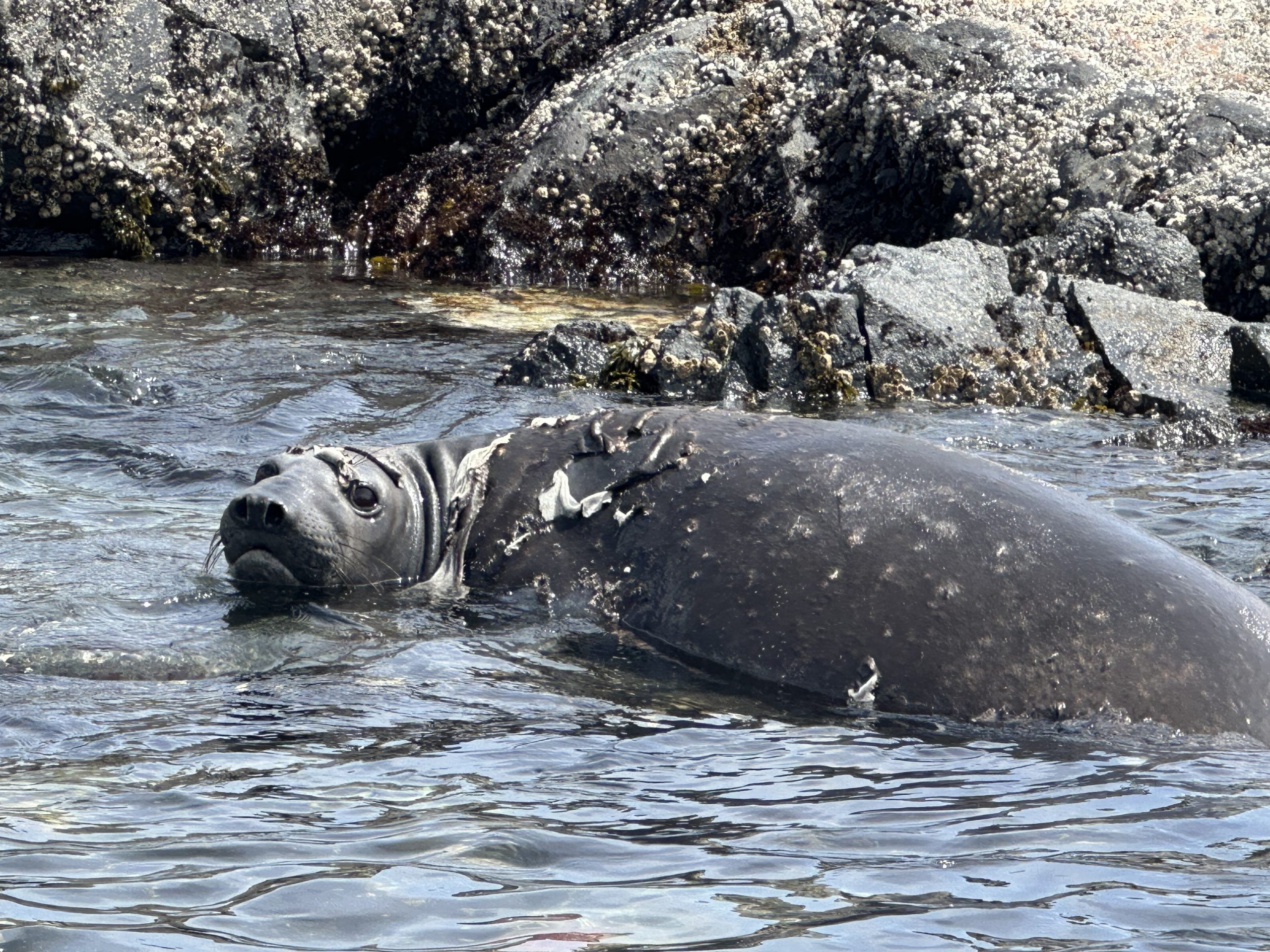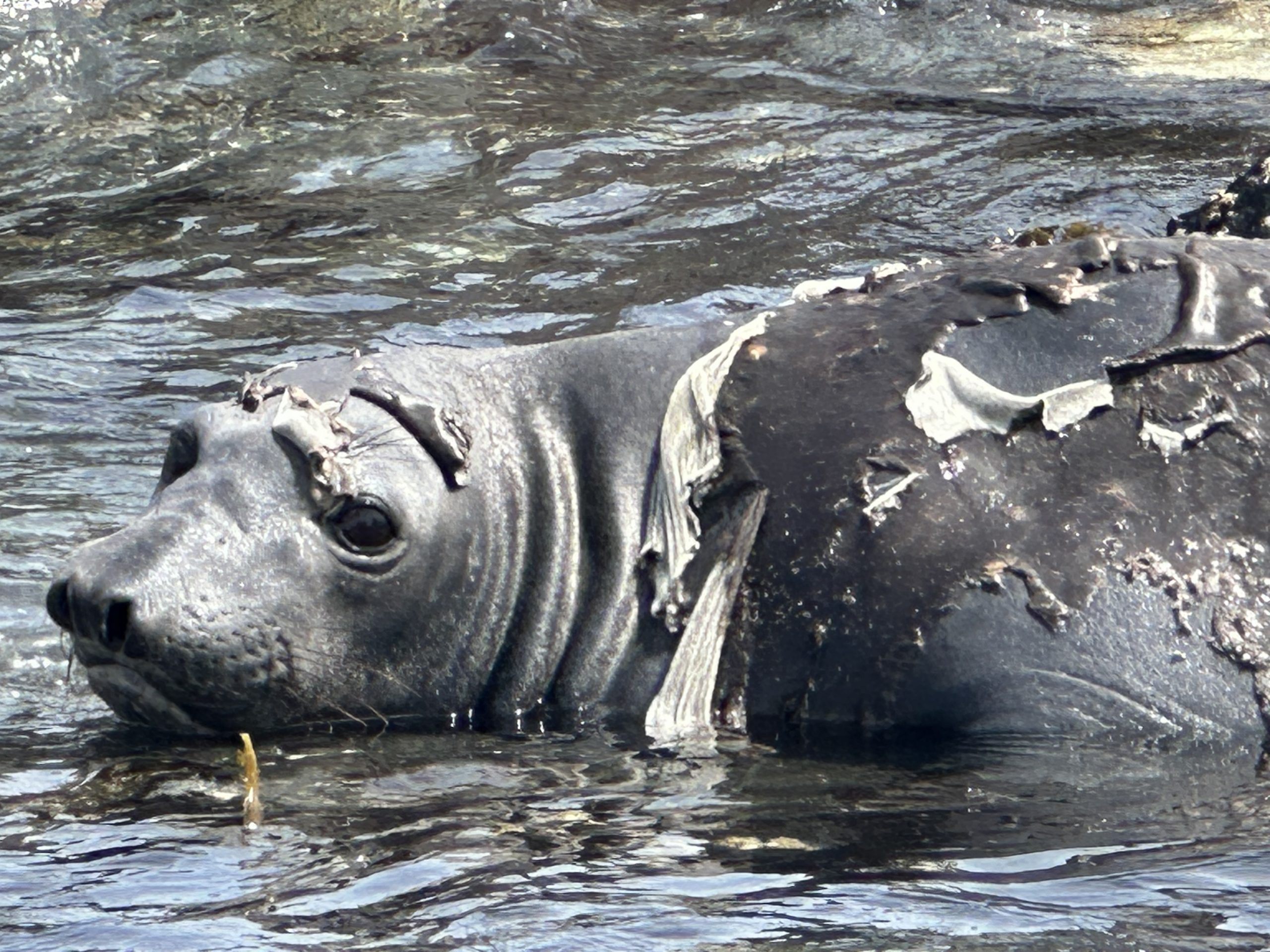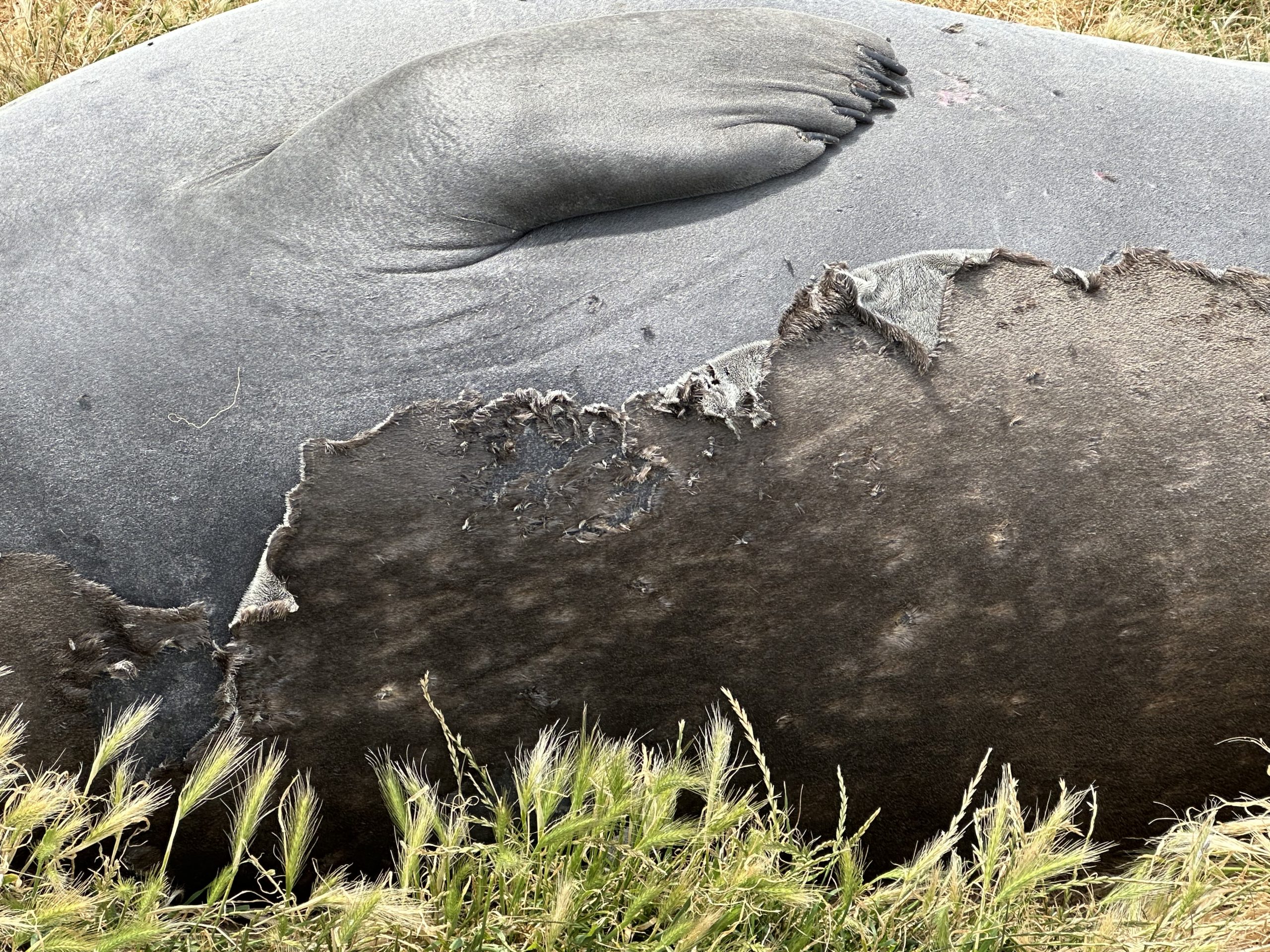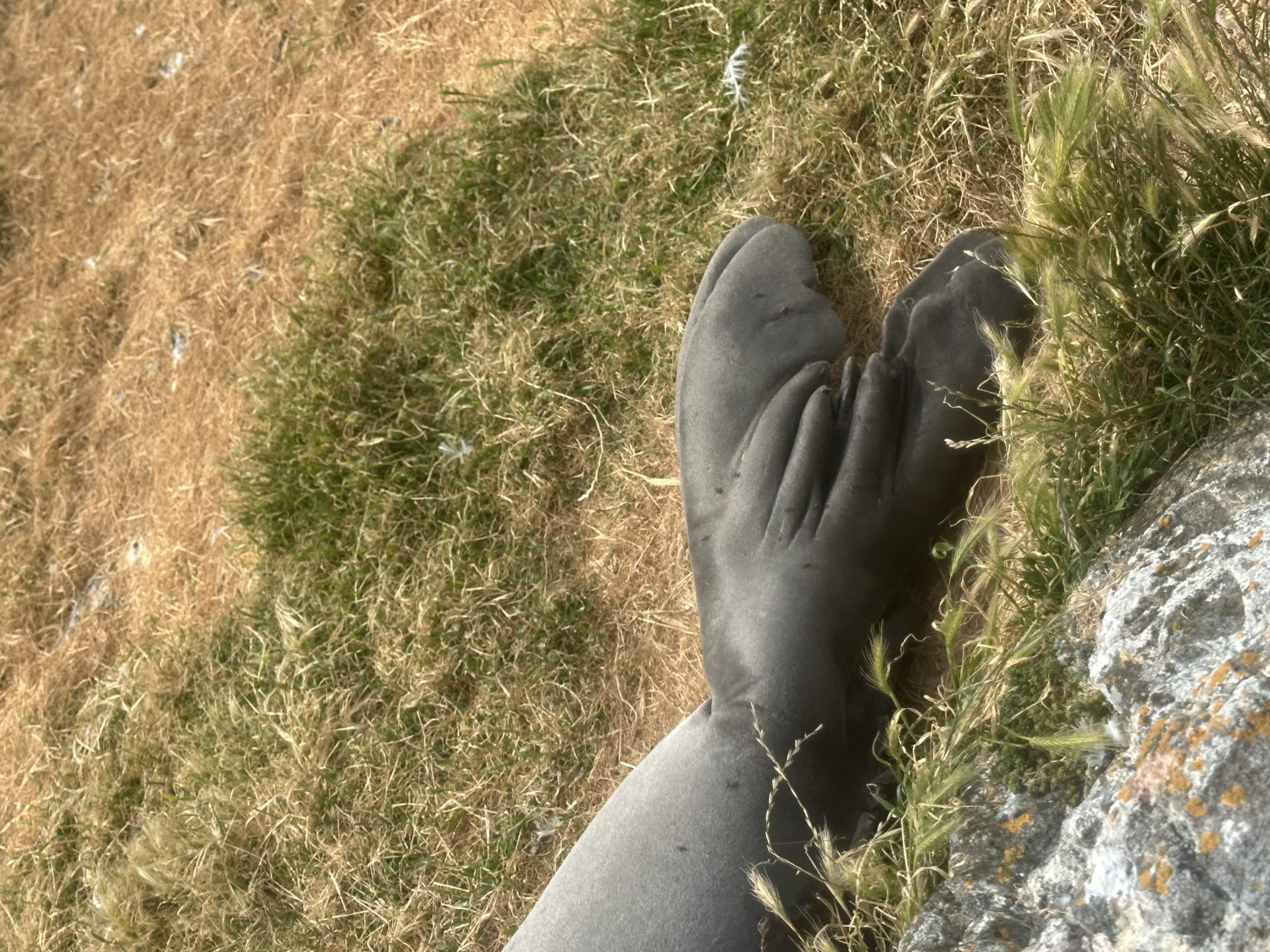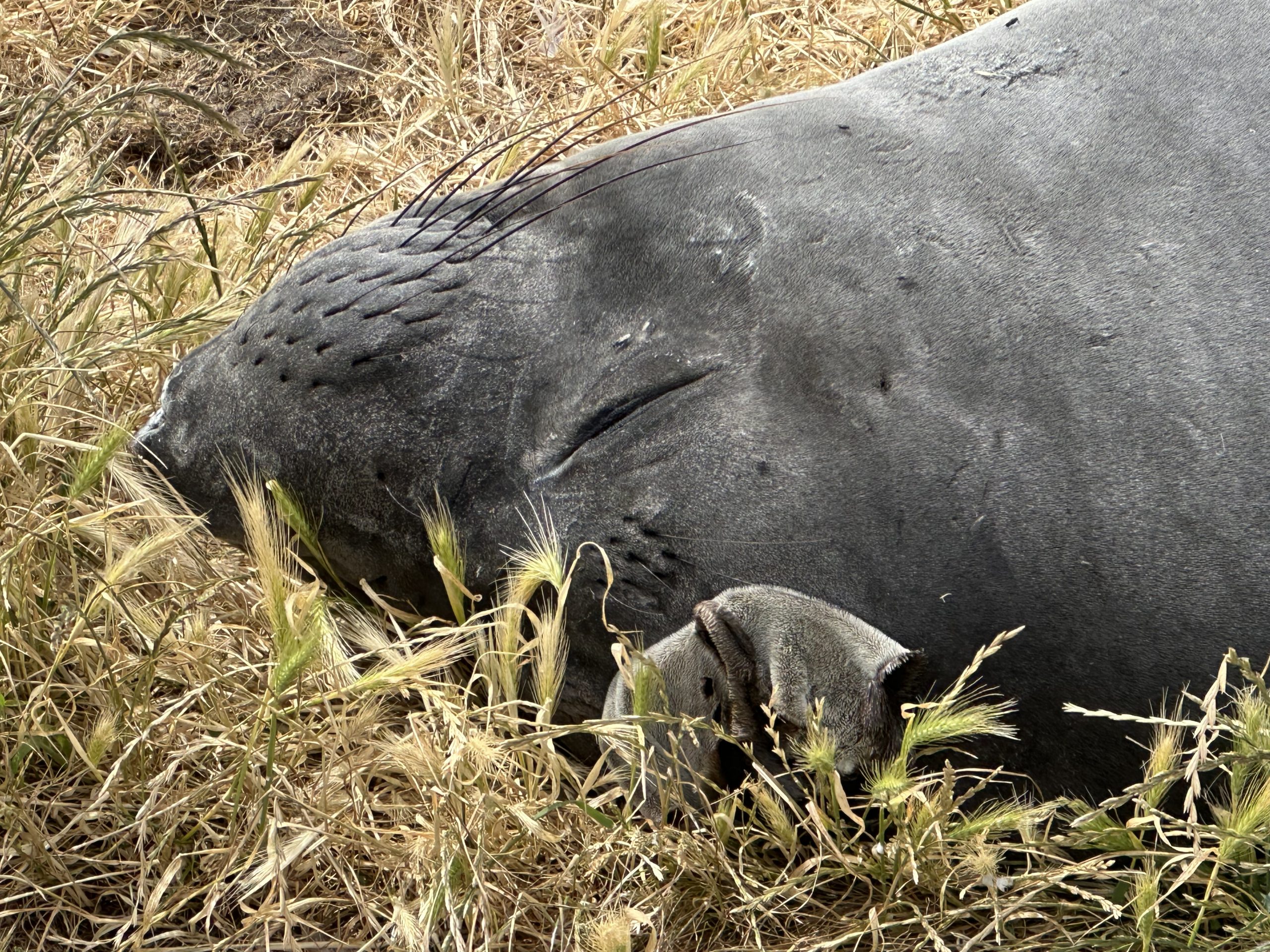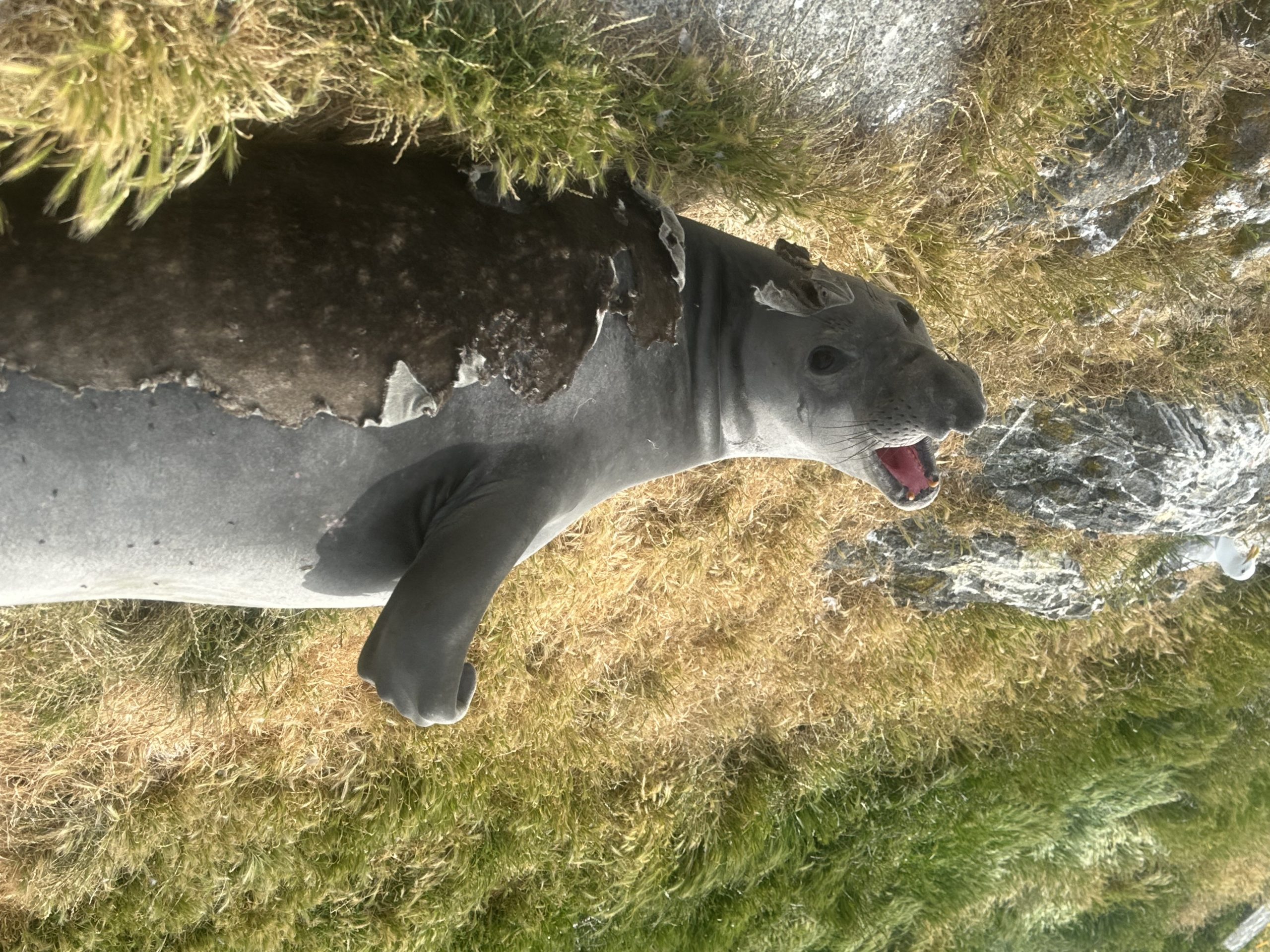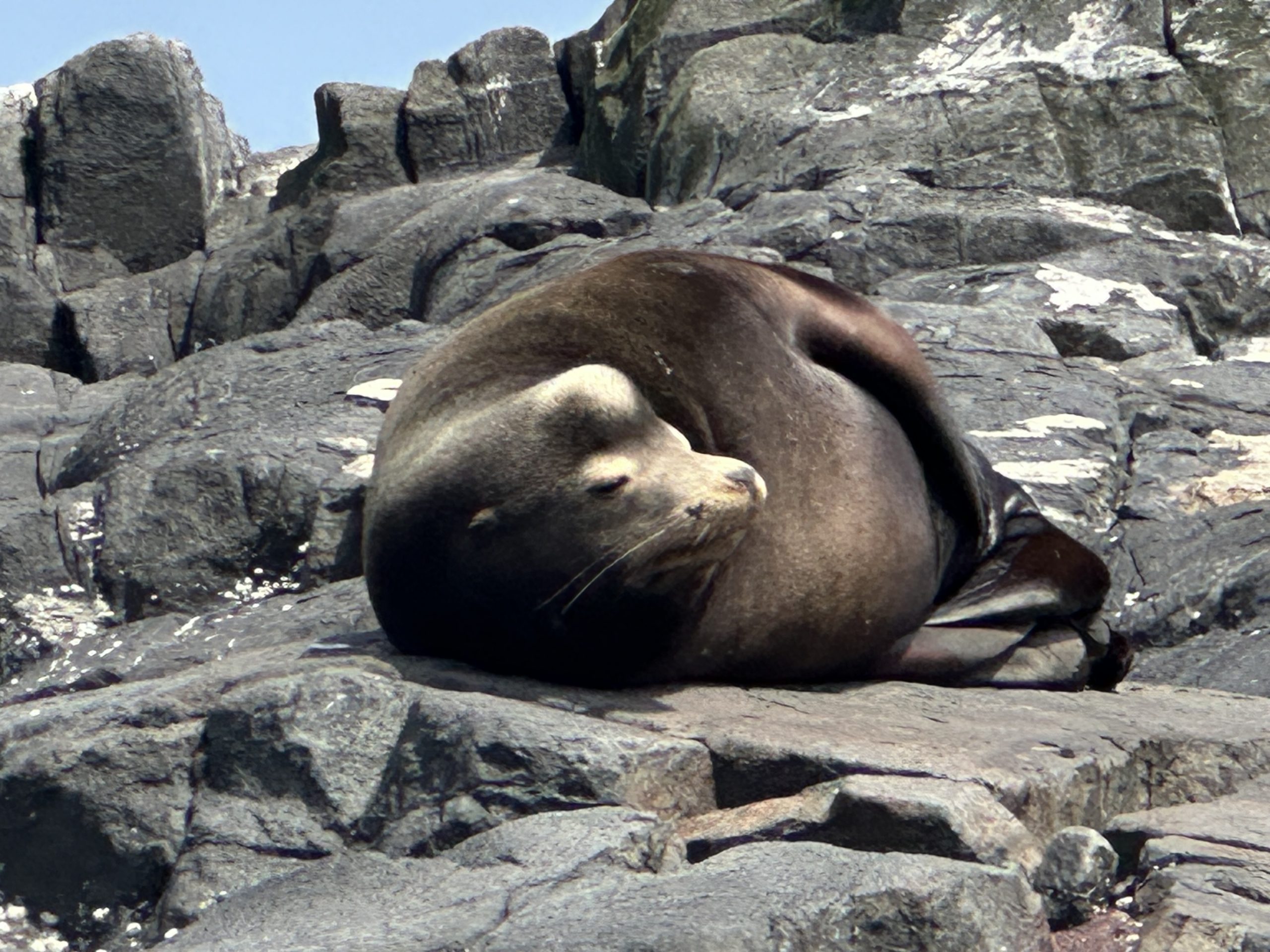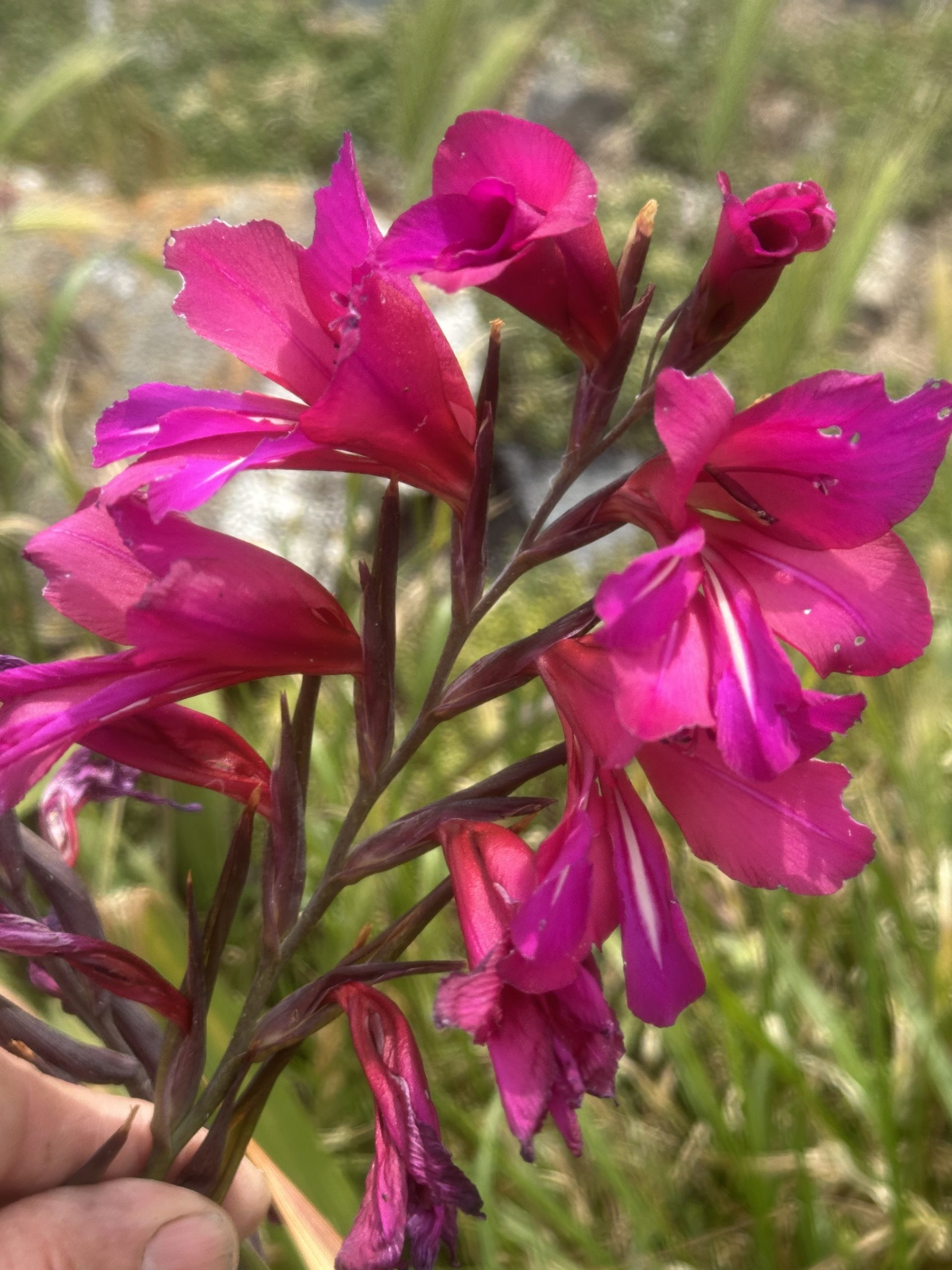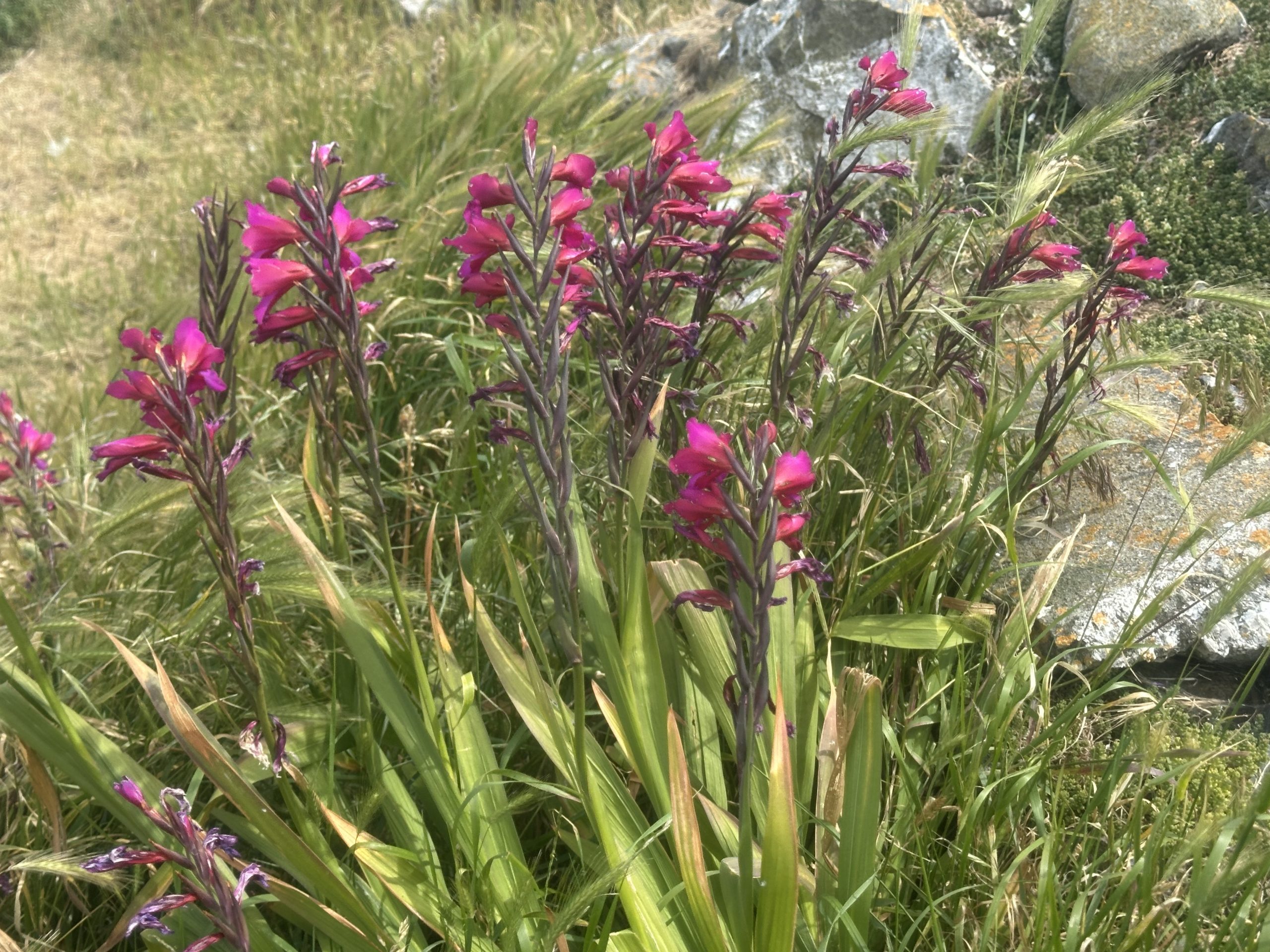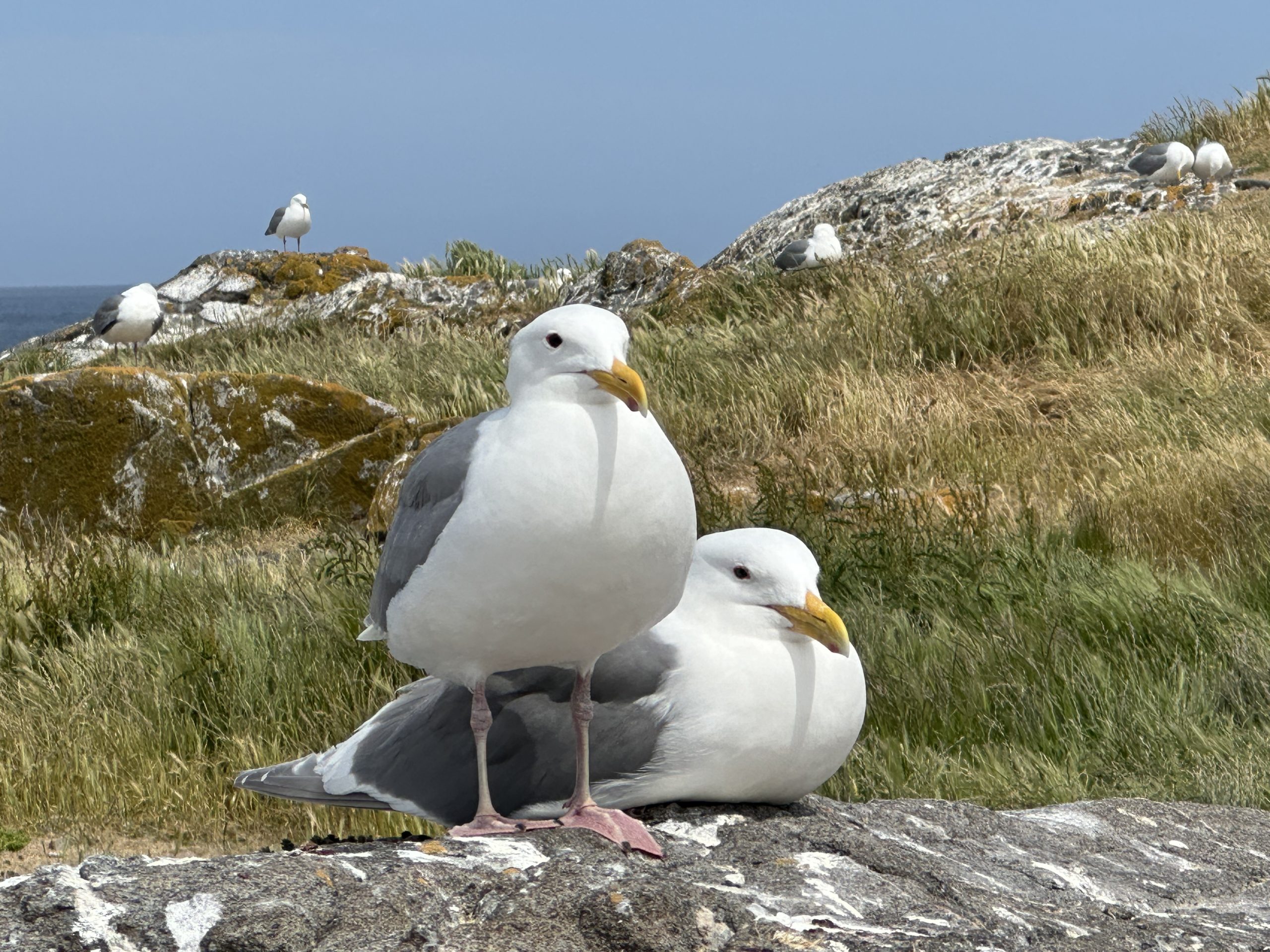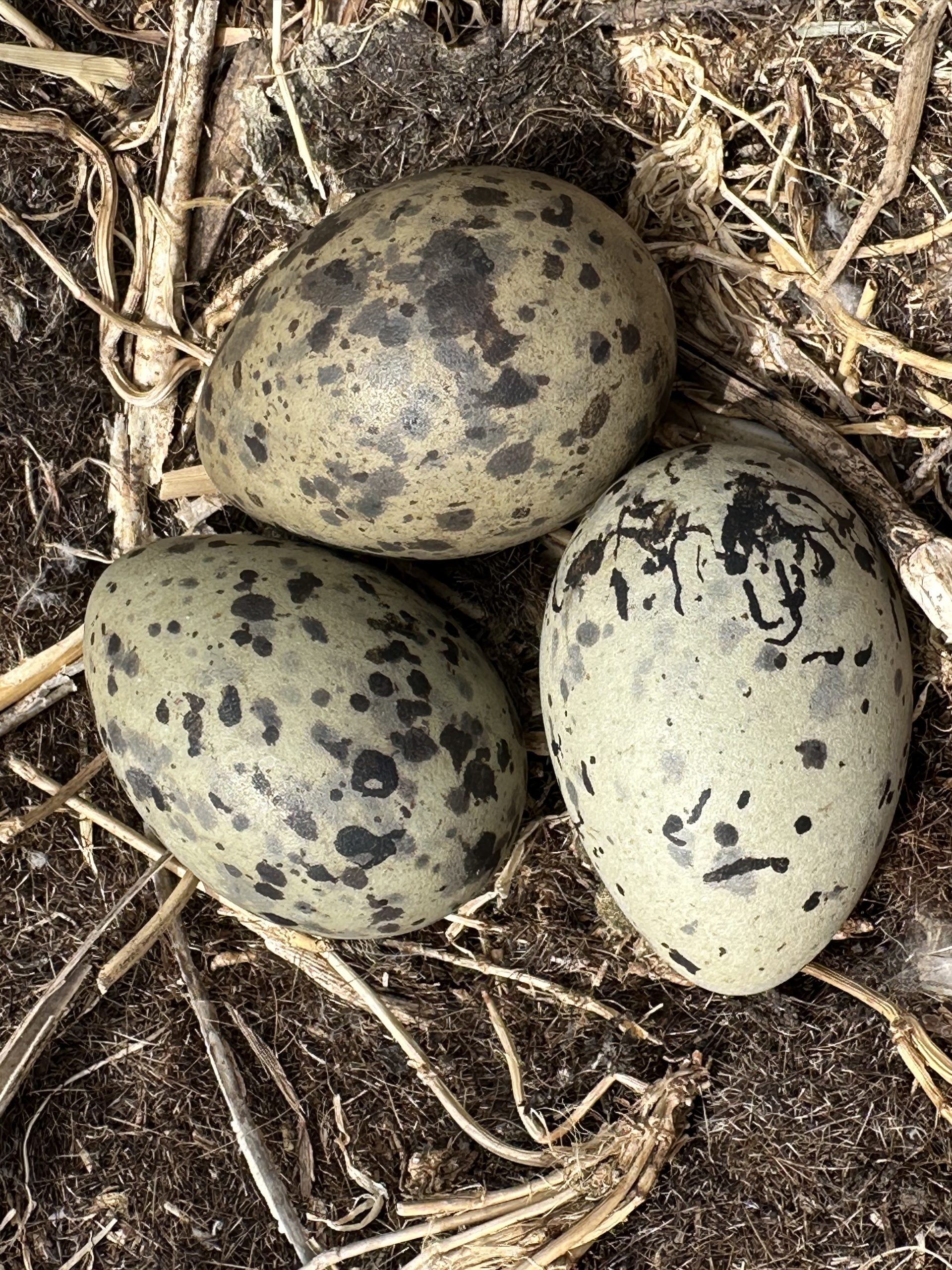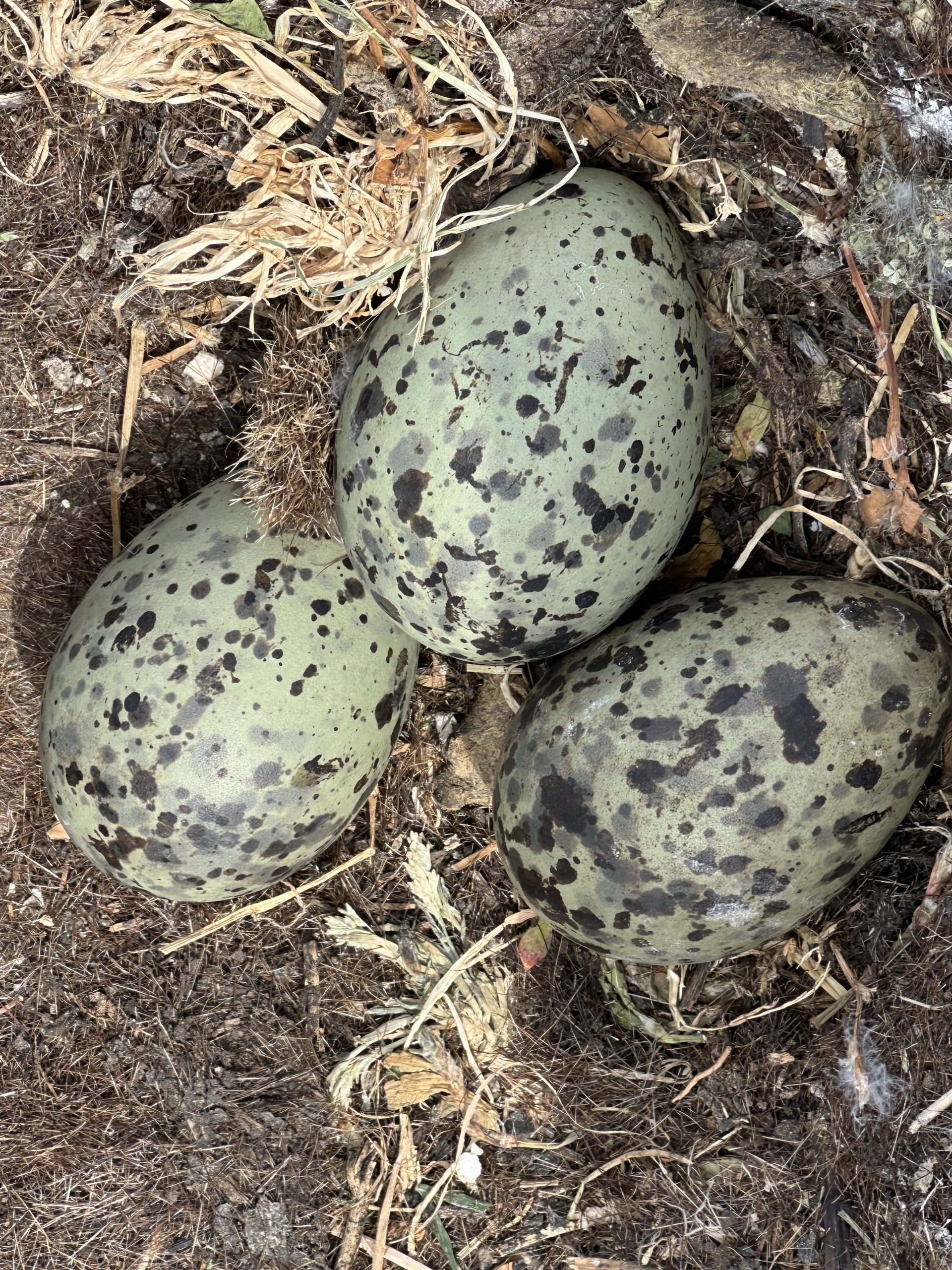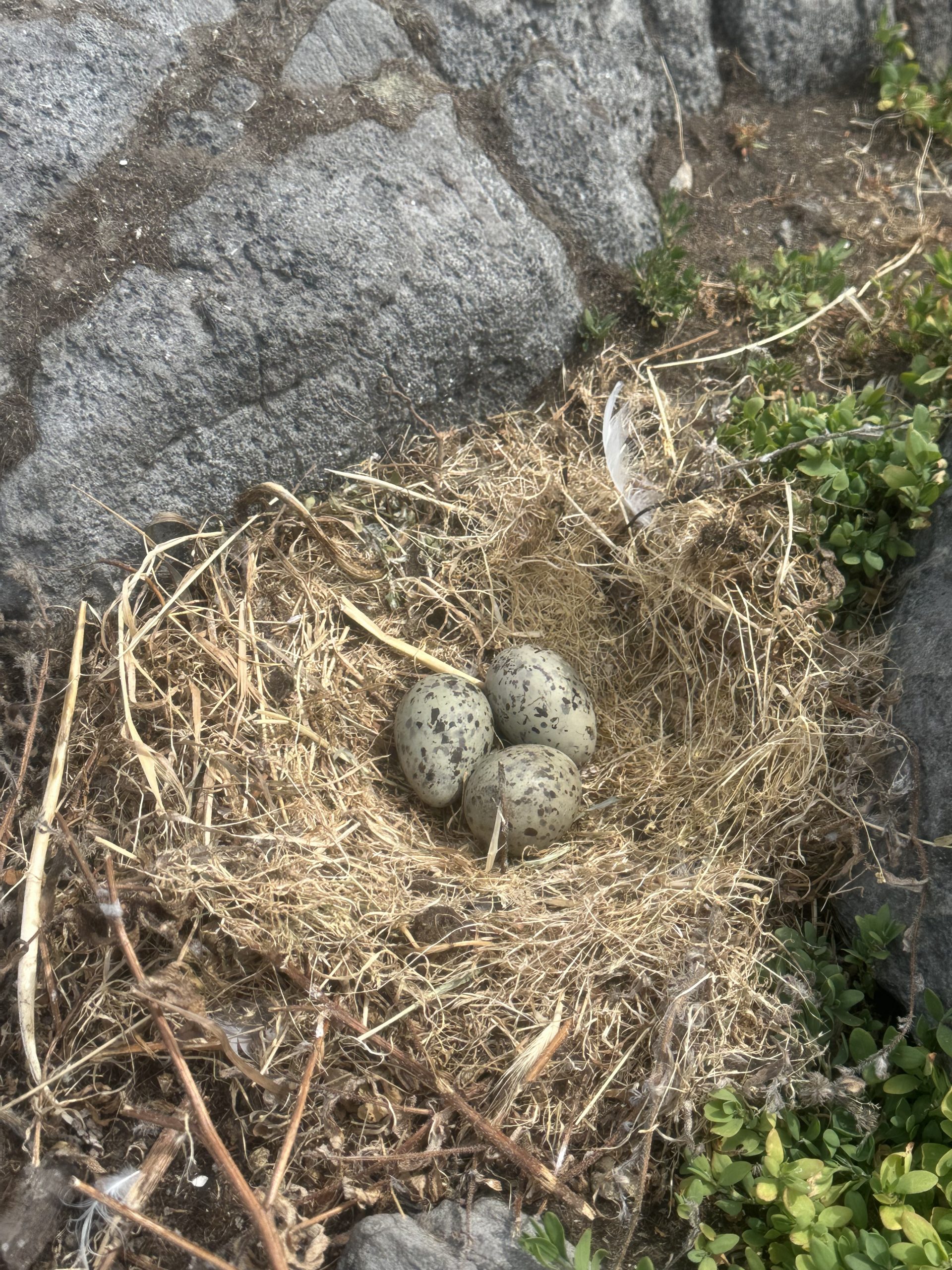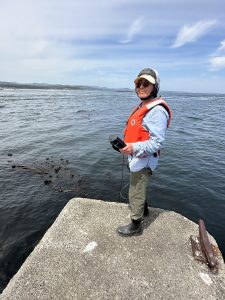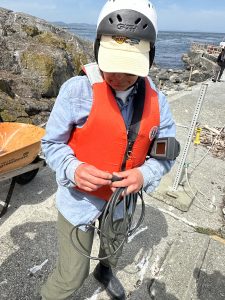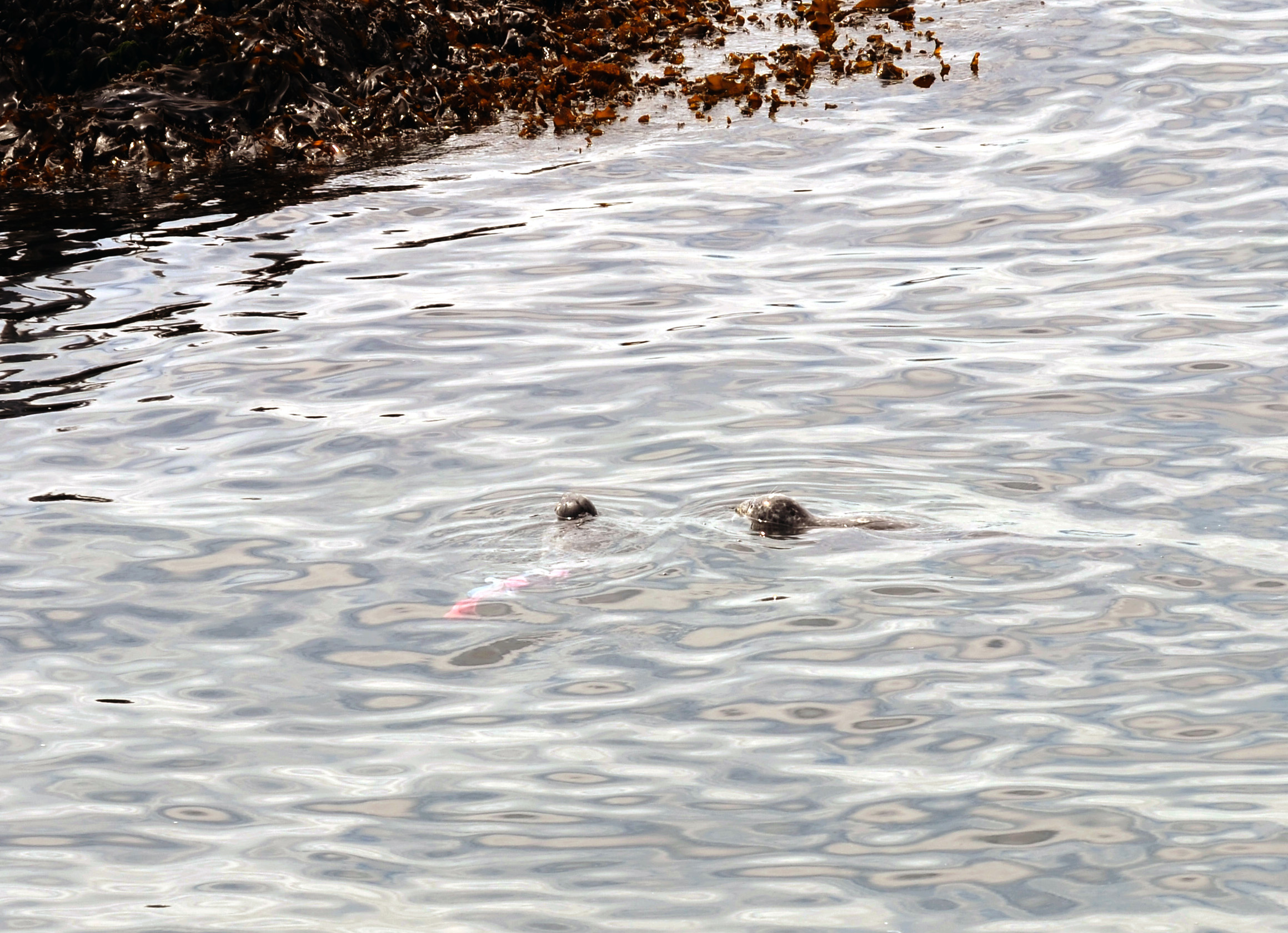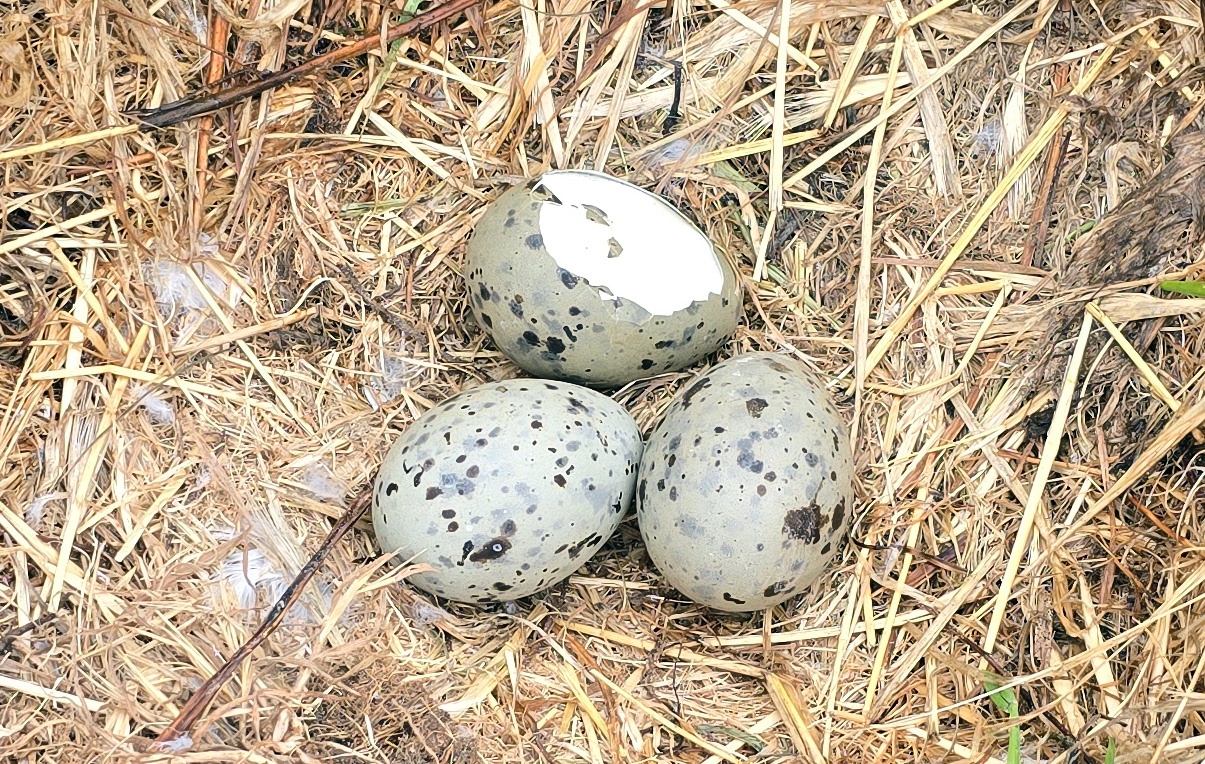Wandering tattler
Wildlife notes
A wandering tattler was feeding at the rocks near the Jetty. I last saw one on May 17. This time I could get good photos and actually sit for a while on the Jetty and watch it bob its tail and feed. I have so many photos – I’ll share just three. With regard to the gulls, nothing out of the ordinary to report. There are still just a few birds left on the nest with eggs and I have been spared seeing chicks killed by angry neighbours. I witnessed some close calls but the chicks were able to stand again and run away. It seems the best outcome results when chicks squat and freeze during an attack. I notice the same for myself – if I move away quickly from an angry, challenging parent on the ground, they chase me, but if I stop and hold my ground, they do the same. This doesn’t work if they are in the air. I was weed whacking today with the ear muffs on completely oblivious to their overhead threats and vocal warnings. I need two hands to hold the tool so there really is no choice but to hope for the best and go change my clothes afterwards. Only four more sleeps. I shall miss this place dearly.
Facility work
- cleaned the solar panels
- weed whacked the walkways
Vessels
- Ecotourism: 12
- Private: 0
Weather
Moderate to fresh westerlies, building to strong in the late afternoon. Daytime temperatures: low 10, high 12.
Cleavers and searocket
Wildlife notes
Sea lions are starting to return in low numbers but they are hauling out on Middle Rock. There are very few gulls left with unhatched eggs and some of the late layers have abandoned their third egg after the first two hatched. The eggs I found previously with their shells partially missing/chipped away (like on July 9th) have been discarded from their nests.
I have two more introduced species on Race Rocks to report. Cleavers, catchweed, sticky willy, or goosegrass (Galium aparine) was found in the rocks behind the Energy Building. Geese seem to eat it and that may explain how it got here. The second plant, European searocket (Cakile maritima), is growing on the boat ramp in a crack in the concrete. It is common in coastal areas in Europe, Asia and North Africa and may have come to North America in ship ballast water.
- Cleavers
- European searocket
Facility work
- cleaned solar panels
- weeding
- studying the Programmers Guide for the Mate3s power system controller and the programmed setpoints
Vessels
- Ecotourism: 21
- Private: 1
Weather
Skies clear. Winds variable and light until late afternoon, moderate SWS in the evening. Daytime temperatures: low 12. high 20.
First warm day
Today we reached 27 degrees C at 5pm (the highest temperature since I arrived on May 15th) but three hours later it was back to a breezy 15 degrees. I have been spoilt and will suffer when I leave Race Rocks and face real heat. Just 6 more sleeps :(
Wildlife notes
The highlights of the day were the 9 pelicans doing a flyby, another harbour seal pup on East Beach and finally, photo confirmation of the least sandpiper. The seal pup was tiny and had different face markings than the last ones at East Beach so it could be a new addition. I sat on the rocks below the compost pile for a while watching it struggle to move higher up the beach to escape the rising water. Sitting still with the flies also gave me a chance photograph the least sandpiper.
Facility work
- cleaned the solar panels
- weekly meeting with Greg
- studying the Outback power systems manual
Vessels
- Ecotourism: 15
- Private: 2
Weather
Mostly light to gentle breeze, direction variable. Skies clear. Daytime temperatures: low 13, high 27.
Grandpa gull
Wildlife notes
Grandparent gulls lost their entire brood, all at once. They nested under the small porch by the north entrance of the Keeper’s House – same place as last year where they successfully raised their chicks. When I first noticed Grandpa gull last year I sent a picture to the local gull expert Andrew Jacobs and asked if this was a particularly old gull as I was wondering about the darkening around its eyes. He said it was a just a pigmentation not related to age. Regardless, the name stuck. I see a lot of him out the window as he likes to sit on the deck railing. Oddly both parents have the same darkened eyes.
Usually when I find a dead chick or see one being killed it has wandered too far from its nest and the protection of its parents, but this is different. Here, all three chicks are very near or even in the nest. Both parents are still alive, so starvation doesn’t make sense. I wonder if it could be sickness or poisoning? Neither are good news.
Facility Work
- cleaned the solar panels
- cleaned the outside windows
- cleaned the back door
- Before
- After
Vessels
- Ecotourism: 22
- Private: 1
Weather
Clear skies. Strong WNW breeze in the morning, moderate WSW in the afternoon. Daytime temperatures: low 13, high 16.
Whale watching
Wildlife notes
Looking at the collections of boats on the horizon everyday I know there are whales around but rarely do I get to see them. Today a humpback was feeding off the jetty and I got to sit in the sunshine and watch this magnificent massive creature. I am glad it is a baleen whale and not a threat to the little seal pups. In the high winds, tide and waves of the early evening the two moms and seal pups are bobbing in the waves in the shallows at East Beach – it seems there must be a lack of haul out spots in these conditions that they can get their pups up on. It will be a tiring time for the little ones.
Facility work
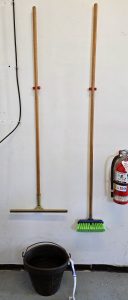 I created a place inside the warm and dry Generator Room to store and hang the solar panel brush and squeegee. These tools are important and having them in good shape saves a lot of water, frustration and time on the roof. The squeegee is a brass Ettore. I call it our Hattori Hanzo squeegee – a prized possession not to be left outside in the salt spray.
I created a place inside the warm and dry Generator Room to store and hang the solar panel brush and squeegee. These tools are important and having them in good shape saves a lot of water, frustration and time on the roof. The squeegee is a brass Ettore. I call it our Hattori Hanzo squeegee – a prized possession not to be left outside in the salt spray.
- cleaned the solar panels
- general house cleaning
Vessels
- Ecotourism: 16
- Private: 3
Weather
Fresh westerly breeze until 3pm with winds rapidly strengthening to near gale force WNW by 4pm. Daytime temperatures: low 11, high 15.
Nature’s soother
Wildlife notes
Harbour seals are bringing their pups to East Beach and I can watch them from the back porch! All of this pup activity must have been going last summer but was I so focused on the birds not to see it?
At 9:30 am I watched a mother leave her pup on the rocks halfway up the beach on low tide. I left to do the panels, had second breakfast, did some more chores and returned at 2:30. The tide had risen to the height where the first pup was dropped off. I was looking for it and spotted a second very young pup, still with its umbilical chord, further down the beach. Both of the pups were calling out (a weak, mournful, heart-retching sound) and very slowly made their way into the water to reunite with their moms. The first pub spent 5 hours alone, a long time I would think for a very young small creature.
- Pup after the water had risen to its resting spot.
- Pup calling out.
I watched the second pup for a while as it moved slowly toward the water. It found a piece of Fucus or rockweed in front of its nose that I think may have looked rather teat-like to the little thing as it reached out and put it in its mouth.
Facility work
- cleaned solar panels and windows on the Energy Building
- topped battery fluids levels
- weeding
Vessels
- Ecotourism: 11
- Private: 0
Weather
Skies clear in the morning, fog patches in the afternoon and evening. Strong breeze throughout the day. Winds WNW in morning, backing to WSW midday, veering to W in afternoon. Daytime temperatures: low 11, high 17.
Race Rocks ER #97 Warden’s Report May 2025
Ecological Reserve warden Garry Fletcher went out to Race Rocks in May 2025 with Laurag Verhegge and Isabelle Groc on the new Pearson College Boat with College staff Richard Taggart and Mike White and electrician Jordan Cole, who was going out to test and repair corroded attachments on some of the Solar Panels
mmAt the mouth of Pedder Bay near the small island on the north side we came across a sea otter foraging for crabs. This was a great opportunity for Isabelle to get some good photos for her project she is doing on Sea Otters.
 On our arrival at the Ecological Reserve, we were greeted at the jetty by the Ecoguardian hired by Lester Pearson College, Christine Chourmourzis. Christine will be there through the next few weeks in July . I might add that I have appreciated her excellent coverage of events at Race Rocks in this log for this website, and she has been an effective warden in looking after the operations on the island.
On our arrival at the Ecological Reserve, we were greeted at the jetty by the Ecoguardian hired by Lester Pearson College, Christine Chourmourzis. Christine will be there through the next few weeks in July . I might add that I have appreciated her excellent coverage of events at Race Rocks in this log for this website, and she has been an effective warden in looking after the operations on the island.
7One female elephant summer has stayed on the island for the summer, normally they have all left by now and return later in the year. she is moulting now. one photogenic California Sea lion also greeted us on arrival.
Chriistine has also discovered several new plant species on the island . showed these to me and i have posted them on iNaturalist where they can be seen at the following link: Eventually they will get their own page in the Biodiversity section here.
I was not able to find any Romanzoffia or mist maidens in one of their usual spots but the long ago introduced Turkish gladiolus has spread to a few new locations East of the Ecoguardians residence.
The Glaucous winged gulls were in full nesting mode and one agressive adult even knocked my hat off while I was on a sidewalk.
One nest contained eggs of different colours .. iI am not sure if that is normal.
 Some records are not being recorded on the Davis weather instrument and after a full cleaning some sensors are still not recording so we are looking into that.
Some records are not being recorded on the Davis weather instrument and after a full cleaning some sensors are still not recording so we are looking into that.
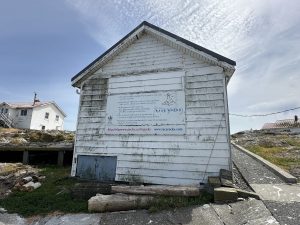 we will be asking BC Parks for a replacement of the ER sign , I has withstood the harsh environment for a good length of time now but is showing wear and missing one section.
we will be asking BC Parks for a replacement of the ER sign , I has withstood the harsh environment for a good length of time now but is showing wear and missing one section.
Christine did the seawater measurements while we were there, A probe is lowered of the end of the jetty to a metre depth every day near high tide These records are submitted monthly to the Institute of Ocean Sciences at Pat Bay. This link provides the seawater récords for past months .
https://racerocks,ca/tag/seawater-data/
One of the ecotourism boats passed by while we were there . In a past agreement made with the ecotourism companies and BC Parks, boats are required to stay in the centre of the channel in order to comply with regulations for marine mammal viewing .
I noticed that the concrete and wood refuse left in piles from previous construction and repair work that was supposed to be taken off the island by a BC Parks vessel are still there after many reminders by Pearson College staff.
iPast warden’s reports are at this link
https://racerocks.ca/category/er-warden-report/
July 11 Census
Mammals:
- Steller sea lion: 1* on Middle Rock
- California sea lion: 1
- Harbour seal: 181 plus 3 pups (July 4: 54 adults, one pup, June 27: 258)
Birds:
- Gulls: 1309* (July 4: 514)
- Pigeon guillemot: 57* (July 4: 163)
- Cormorants: 28
- Bald eagle: 3
- Black oystercatcher: 18 adults (only saw 4 chicks today, likely 10 or more)
- Harlequin duck: 2
- Surfbird: 21
- Black turnstone: 45
- Ruddy turnstone: 1
- Western sandpiper: 6
- Short-billed dowitcher: 1
Wildlife seen this week inside the reserve but not observed today is one humpback whale.
* Notes on census numbers
- The Stellar sea lion on Middle Rock is likely injured. It is too far away to properly observe or photograph well from Great Race Rocks. I reached out to Eagle Wing Tours who will be photographing and observing the animal over the weekend.
- The pigeon guillemots count today is not reflective of the actual numbers living and nesting on the island. The count from June 19 is more representative.
- There was an exceptional number of gulls on the islands today and yesterday. The visiting gulls are a mix of adult and immature California, glaucous-wing, Western and Heerman’s gulls. I have broken down the total count of 1309 gulls by location
257 – South Islands
345 – Seal Rocks
4 – Middle Rock
151 – Great Race Rock, on the periphery beyond the area with gull nests
552 – Great Race Rocks, inside the nesting area
Wildlife notes
The pigeon guillemot chicks are hatching. I have viewed several nests and the chicks vary in size.
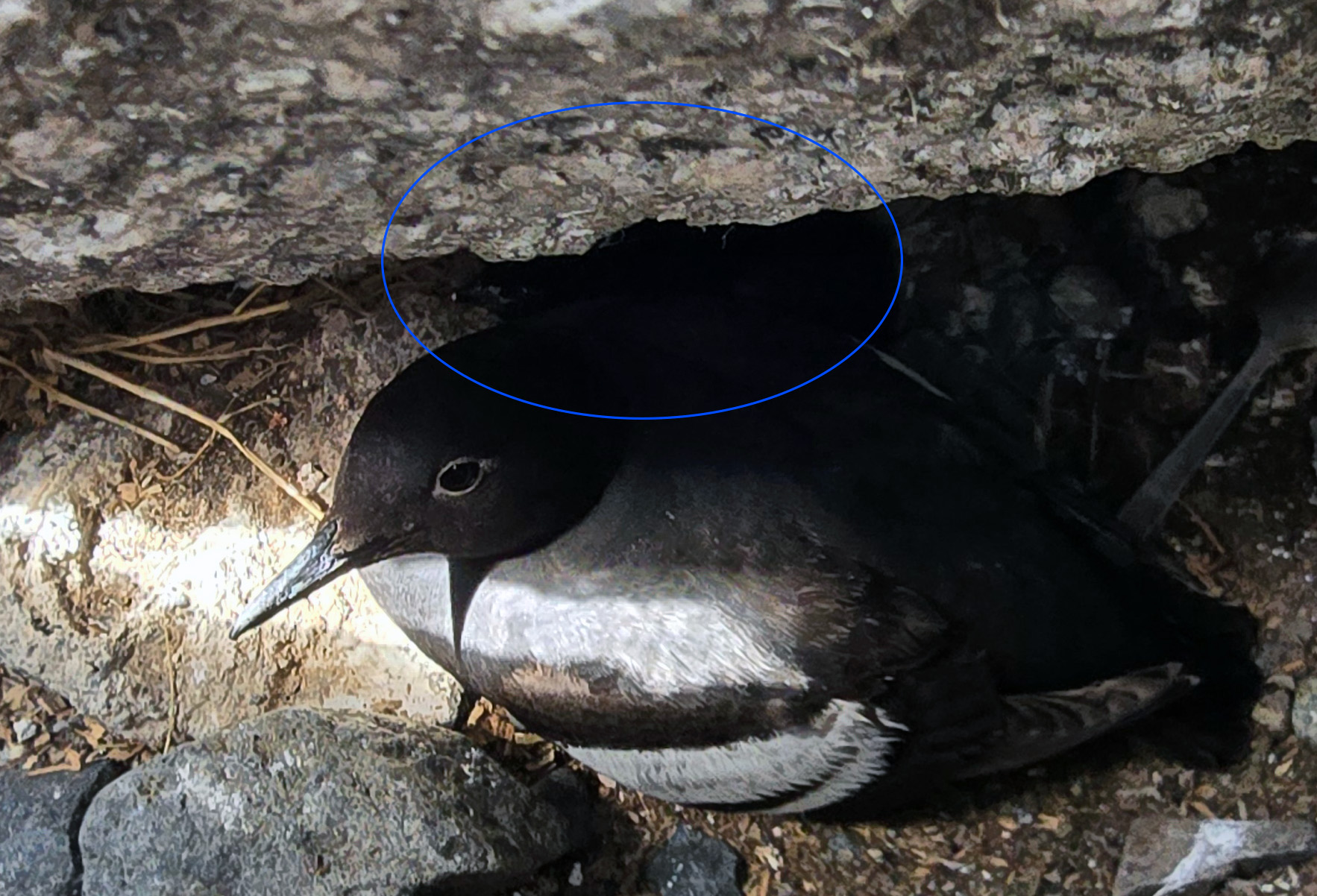
Pigeon guillemot in burrow with chick (in the blue circle). Burrow is near the boat ramp, taken July 10th.
The Energy Building oystercatchers have no more eggs on the nest. They had two eggs until July 5 and a single egg was present until today (5 to 6 day period). The parents have remained on the beach in the rocks near the nest. It is possible that both have hatched but I have not been able to spot any chicks. The Keepers House oystercatcher pair have two chicks that hatched several days apart and their chicks are still obviously different in size. Their first chick hatched June 28th and the mother remained on and near the nest until July 3rd. There is about a months time between when the East Beach oystercatchers and the Energy Building oystercatcher eggs hatched.
Facility work
- cleaned solar panels
- weeding
Vessels
- Ecotourism: 17
- Private: 4
Weather
Moderate westerlies in the morning with periods of fog. Wind strengthening to gale force gusting 40 knots by evening. Daytime temperatures: low 10, high 16.
Afterbirth
Wildlife notes
I always gaze about when I’m on the roof of the Energy Building cleaning the solar panels. This morning a flash of red caught my attention near a small harbour seal pup and mom swimming between the southwest shore and South Seal Rocks. It was the placenta trailing behind the pup! They disappeared from view 15 minutes later with the placenta still attached. It is heartwarming to observe the close physical contact between females and their pubs on land and in the sea swimming together as they roll, swirl, bend and touch noses to smell each other. We know there at least three new pups: the one first observed on July 2, the pup on the boat ramp July 5, and today’s pup.
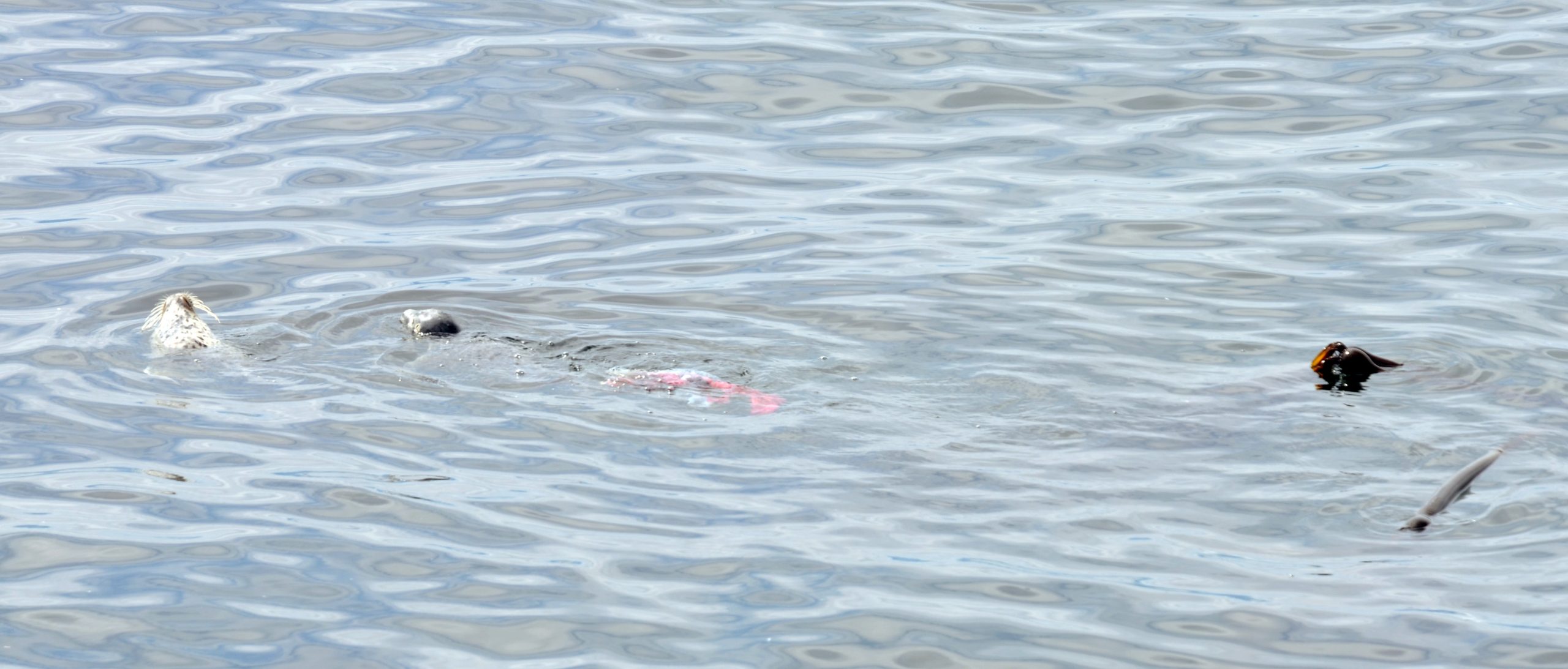
Harbour seal mom and pup swimming to toward South Seal Rocks. The placenta is trailing behind the pub
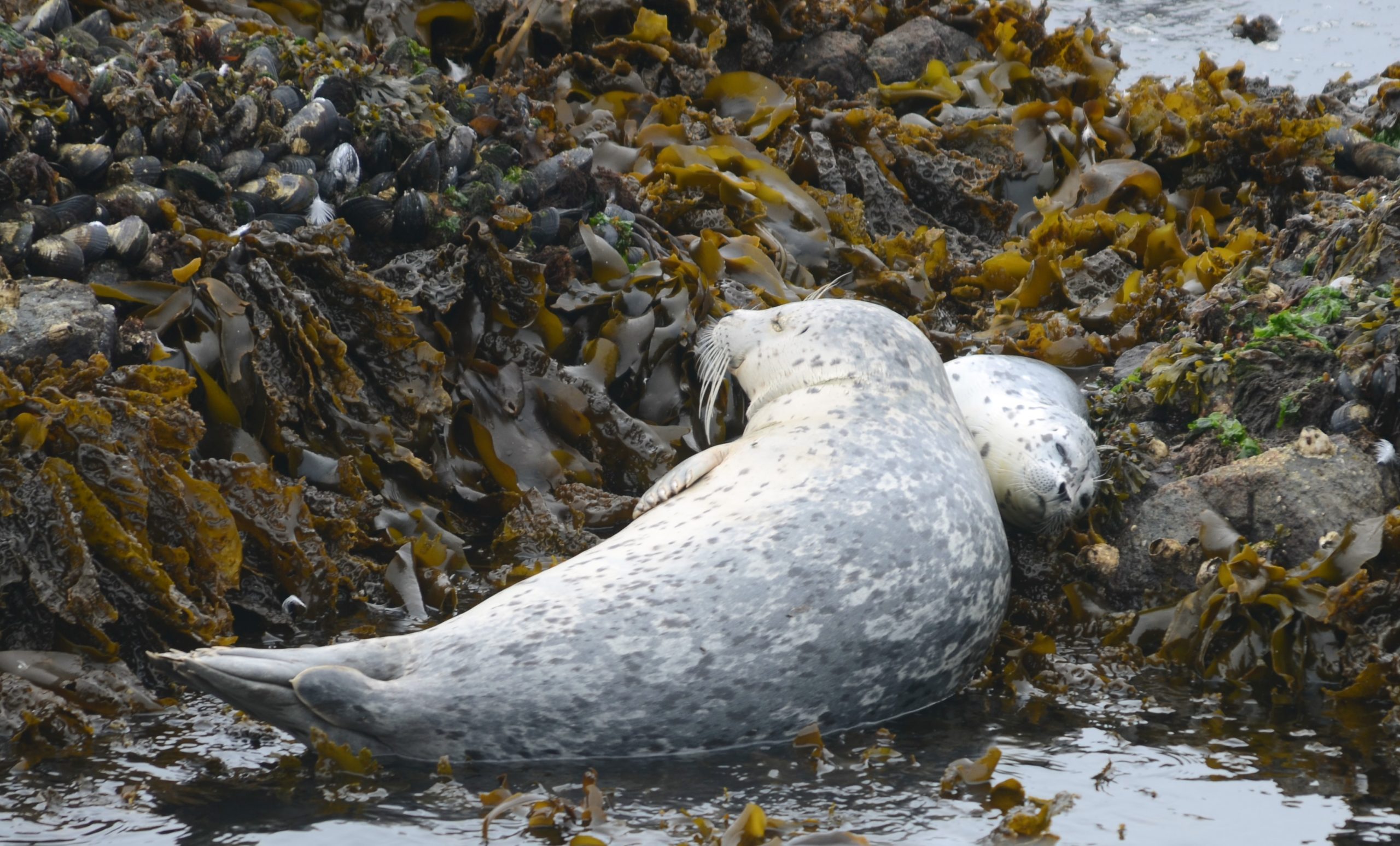
Harbour seal with her pub on the shore by the Energy Building. By the colouring and markings on the pub’s face it seems to be same one as first observed on July 2 and 3rd.
Facility work
- cleaned the solar panels
- weed whacking
Vessels
- Ecotourism: 17
- Private: 2
- Rowboat: 1
Weather
Winds light to moderate, mostly westerly. Skies partly cloudy. Daytime temperatures: low 13, high 18.
Cloaca
Sign gull was so pleasant when sitting on her eggs. Quiet, cute, muted yeows when I walked by or climbed the rock to raise or lower flag. When a visitor came to the island and worried about the gulls, I’d say oh don’t worry about that one, she is nice. Her chicks are running around now and those days are over. Today she made contact and I received a blow to the back of the head and a complimentary load of poo dumped down my back and arm. I also got nailed cleaning the solar panels and then going down to the Jetty to do the sea water measurements.
With all the mention of gull poo, I thought I would devote this entry to the cloaca. Gulls have only one rear opening (orifice), the cloaca, that they use for everything: mating, laying eggs and for excreting wastes. Wastes from both their digestive (feces or poo), and urinary systems (uric acid or pee – we humans make more water intensive urea) are released simultaneously from the cloaca and then dumped on me. The white part is the uric acid and the coloured or granular parts are the feces. So technically I am not just getting pooped on and the official name for this excrement is guano, although this term is used most famously for the dried accumulations of their excrement. Guano or “white gold” is an excellent, valuable, nitrogen-rich fertilizer that was in demand world wide. There is a period in history called the Guano Age (1802–1884) where countries were claiming or annexing islands to get a supply of guano. The Guano Era (1845 – 1866) was a prosperous time for Peru but not for the sea bird who suffered from habitat destruction. With its wealth Peru was able to pay off its debt, abolish indigenous tribute and African slavery and reform its education and judicial system.
Lastly, guano is also famous as the namesake of one of the four nucleotide bases that make up our DNA: A,C,G,T – adenine, cytosine, guanine, thymine. A and G are nitrogenous purine bases.
Sources and links from Wikipedia to read more: Bird Anatomy, Guano, Nucleotide base
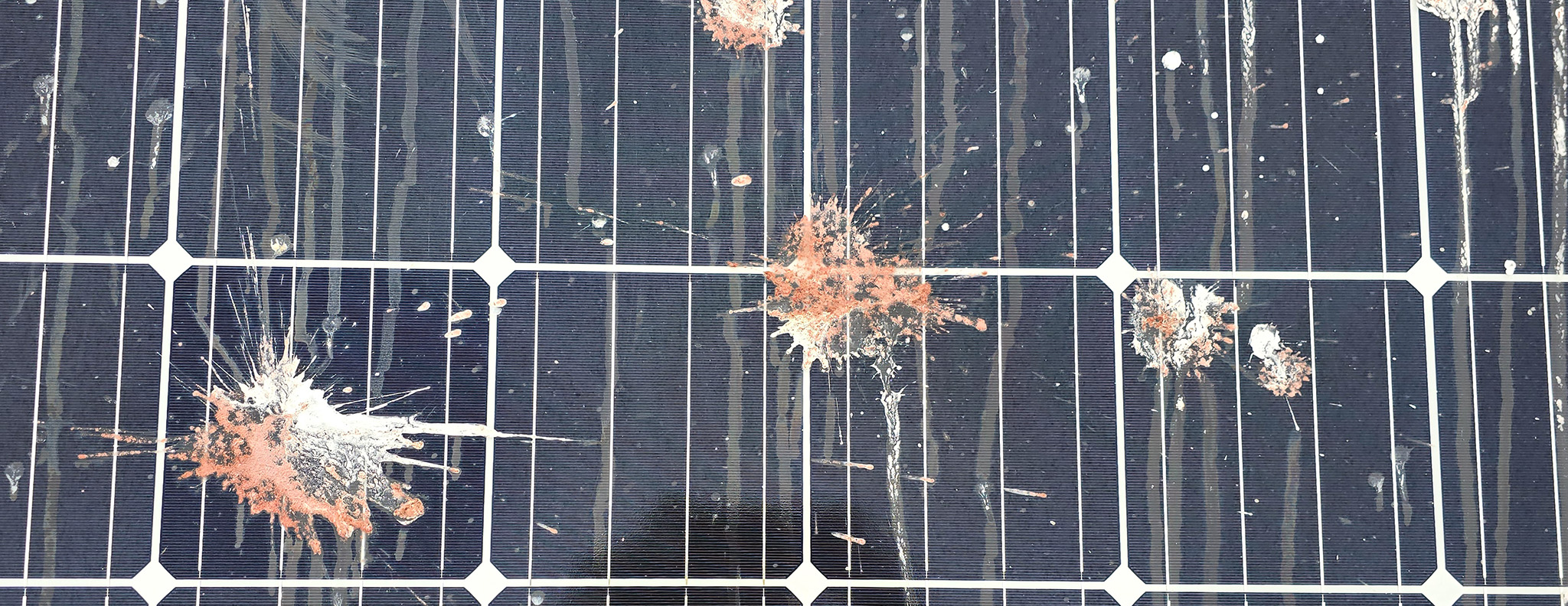
The work of Jackson Pollock Seagull on the Energy Building roof. The white stuff is uric acid, the coloured stuff their feces.
Wildlife notes
One California sealion has returned – the sealions have not been around for a while. A large number of visiting, non-nesting gulls of California, western and glaucous-winged gulls were seen on the western rocks today. I also found a nest with an egg that had parts of its shell chipped away but with the egg membrane still intact.
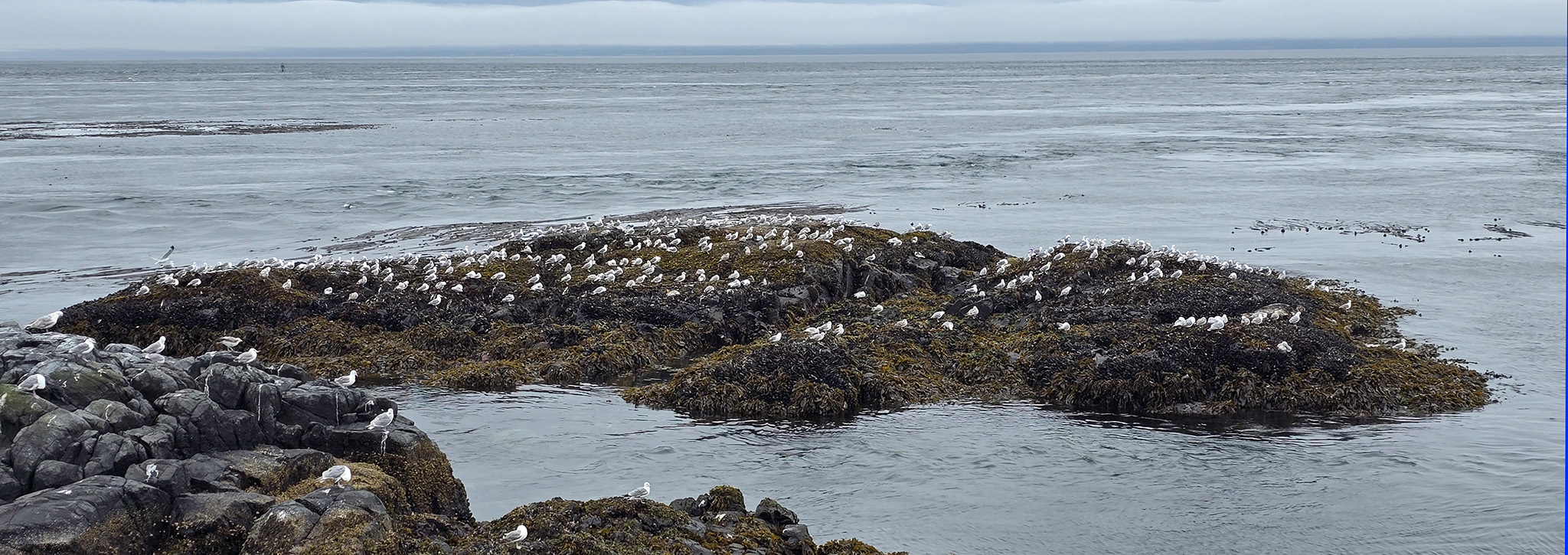
A large collection of gulls on one of the South Seal Rocks. The harbour seals have other to themselves.
Facility notes
- cleaned solar panels
- ran the generator for the first time since June 27th
- cleaned the outside windows
- chopped kindling
Vessels
- Ecotourism: 9
- Private: 1
Weather
Rain and overcast in the morning with a fresh breeze of variable directions. Skies clearing and winds strengthening in the afternoon. Near gale force WNW winds in the evening. Daytime temperatures: low 12, high 15.

